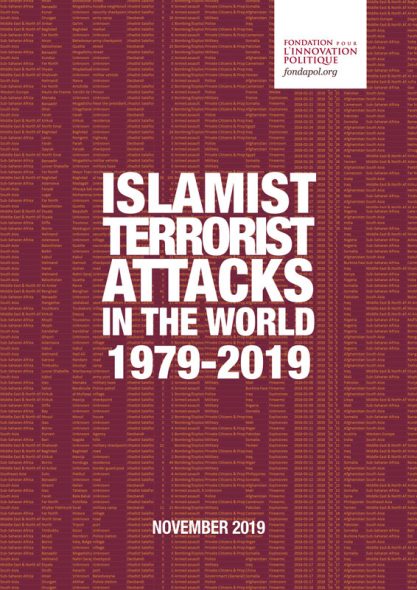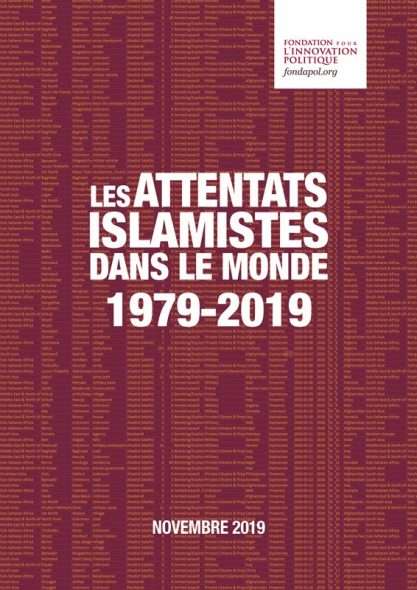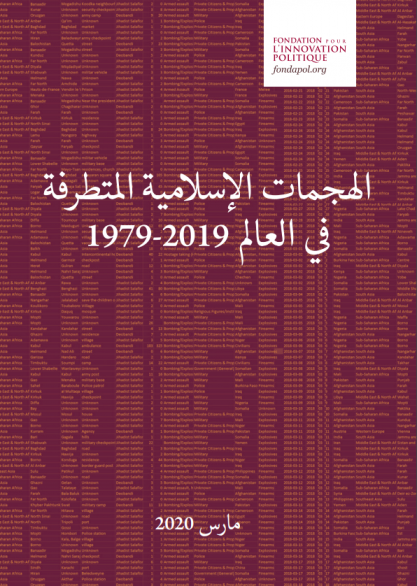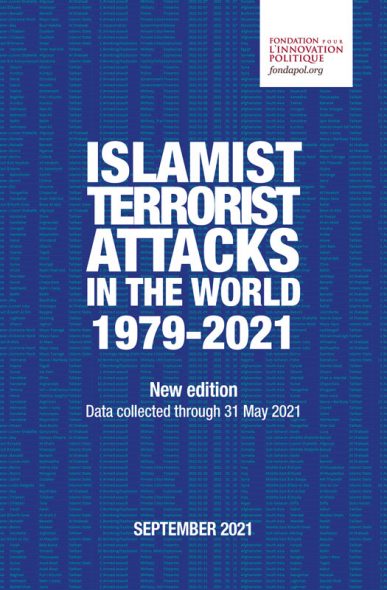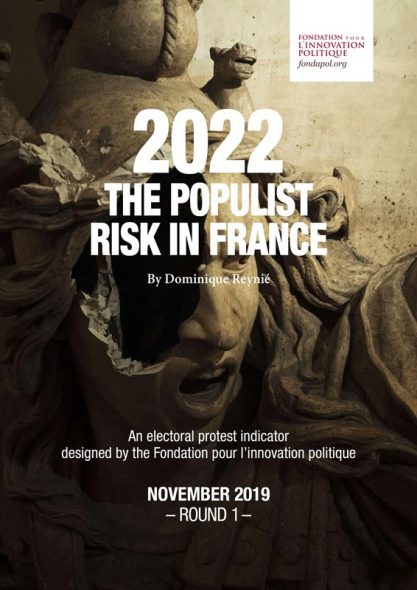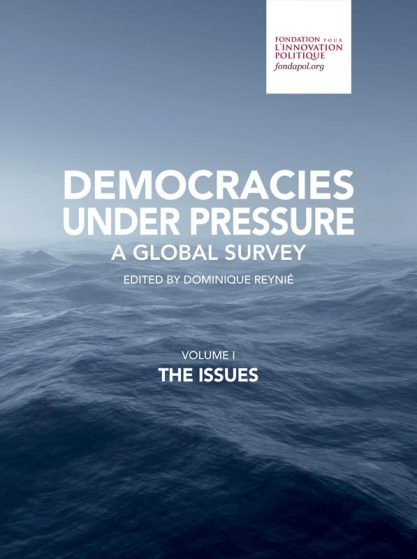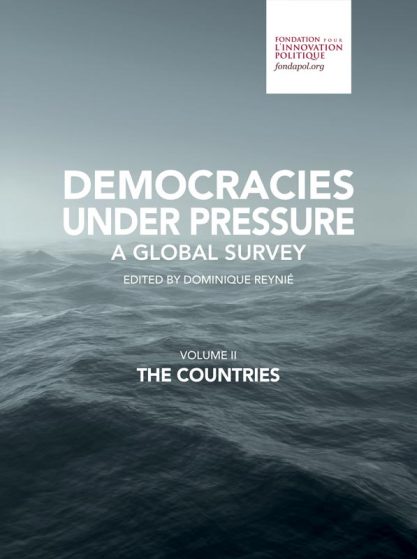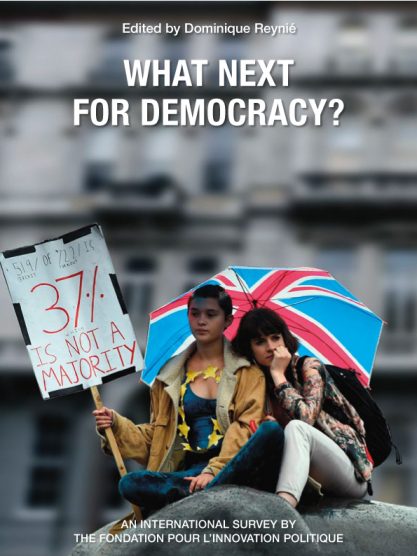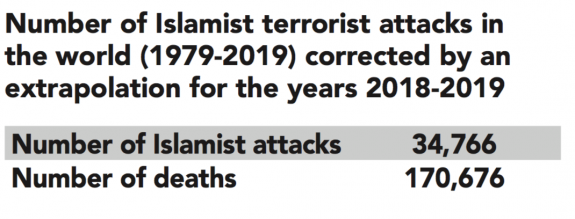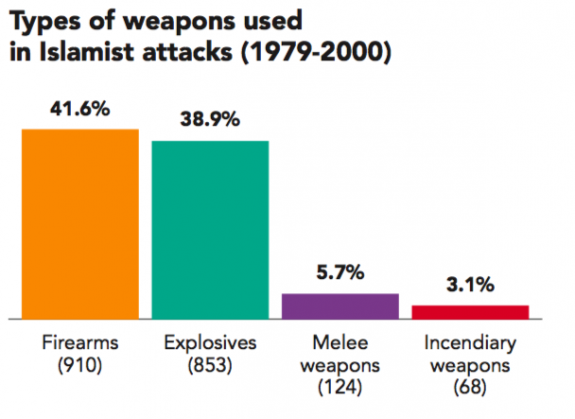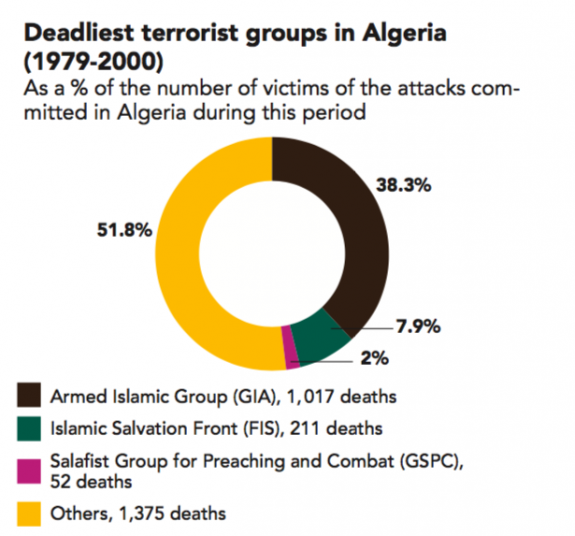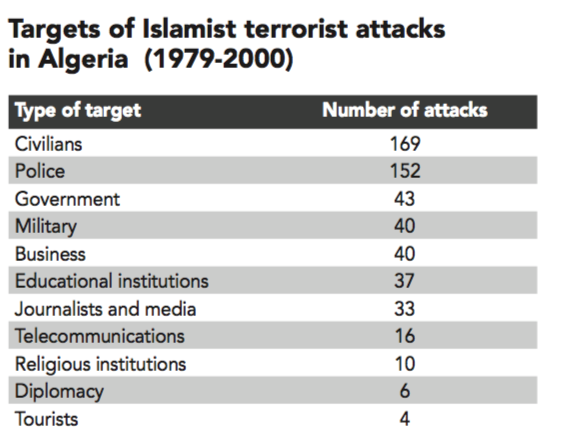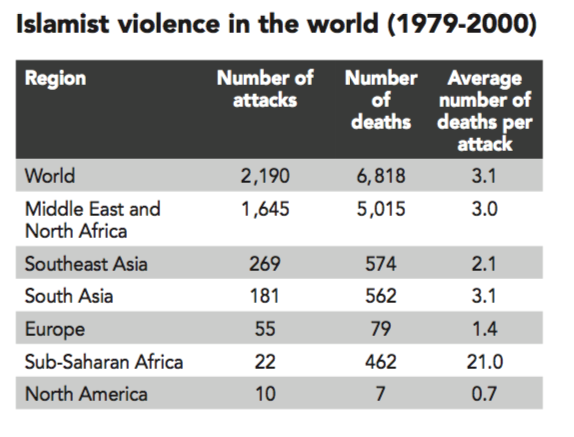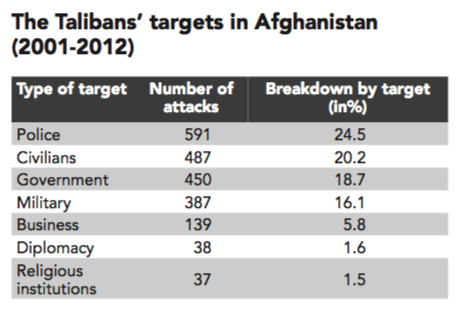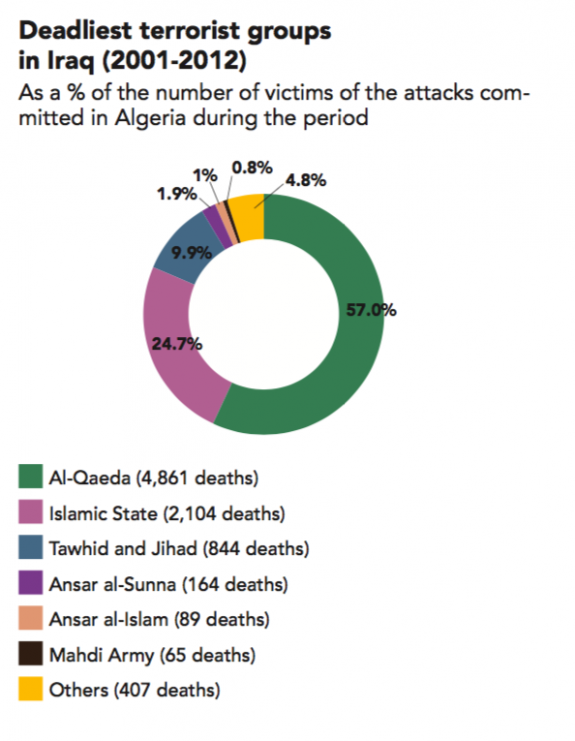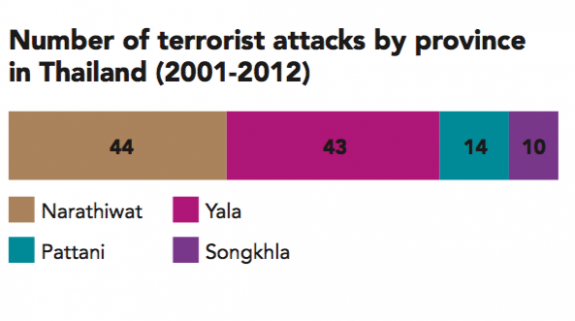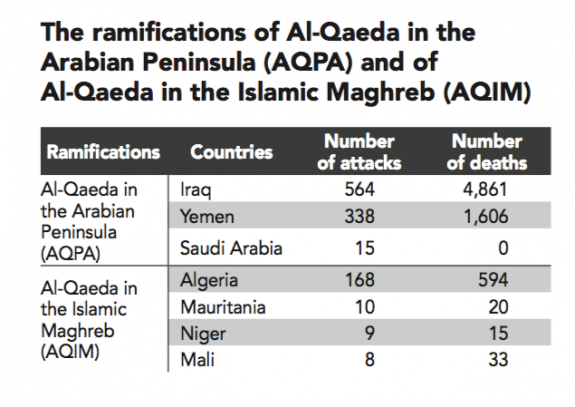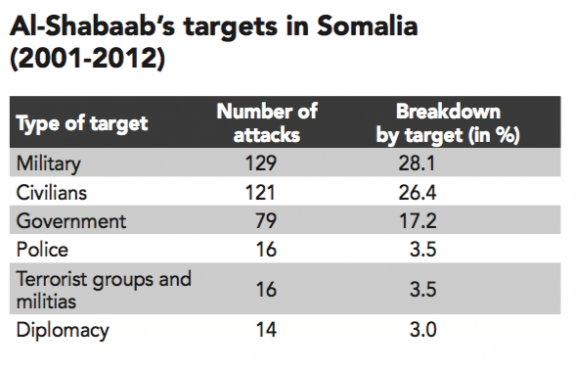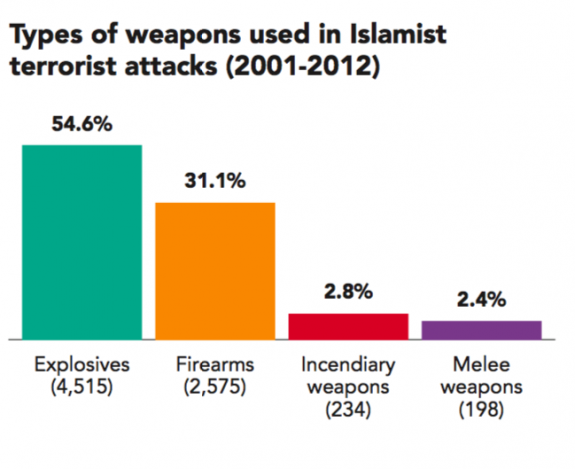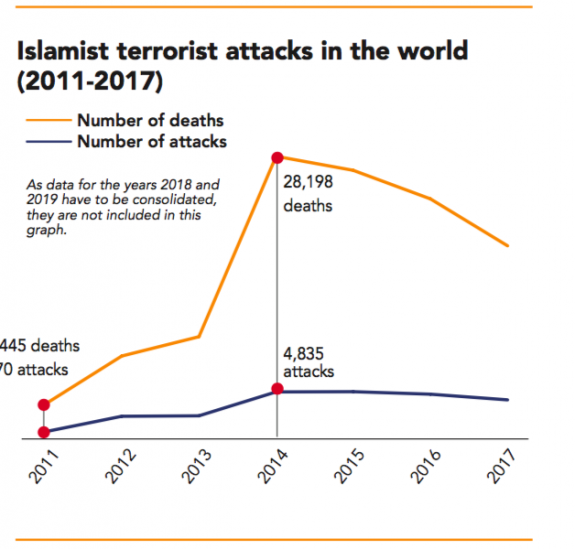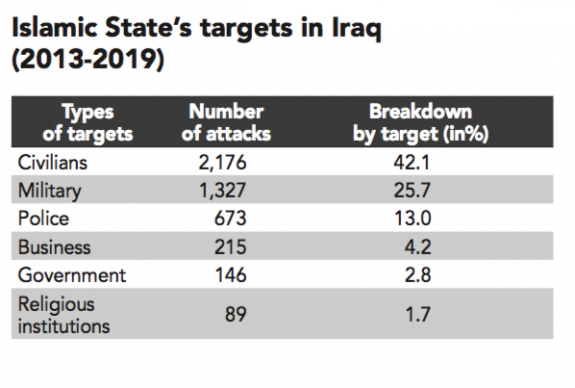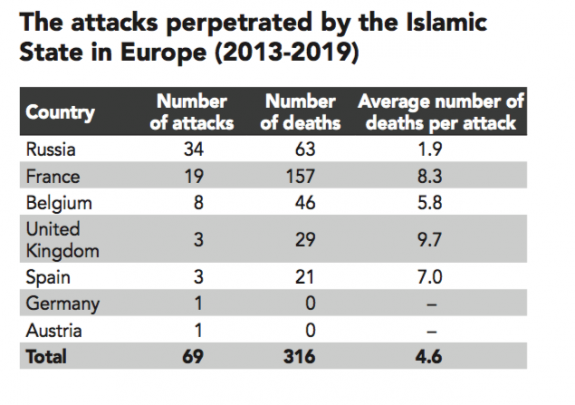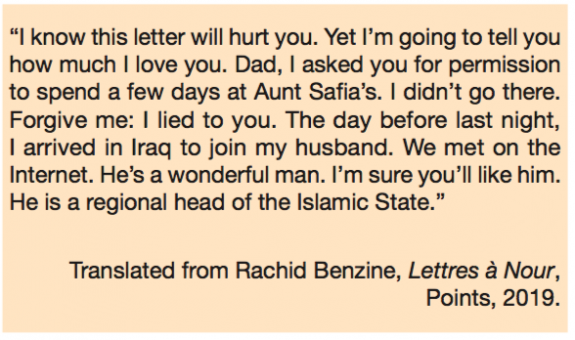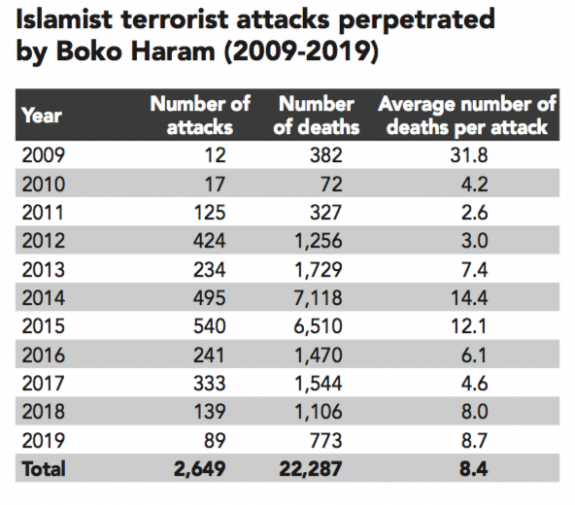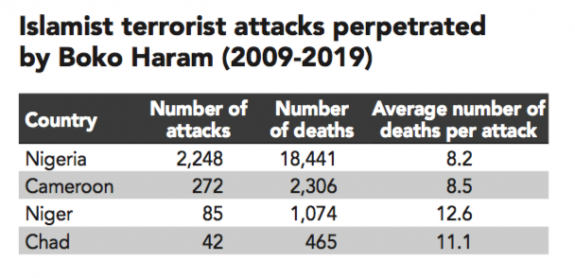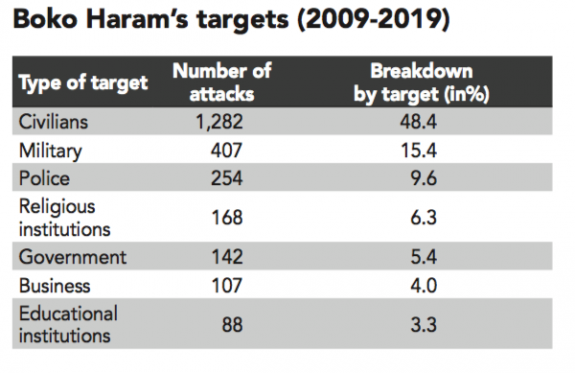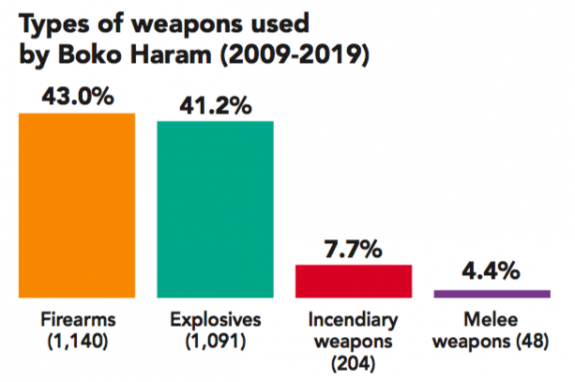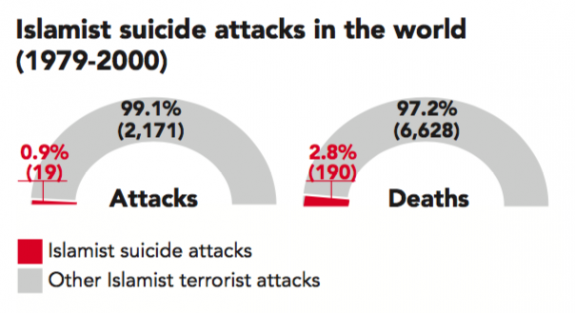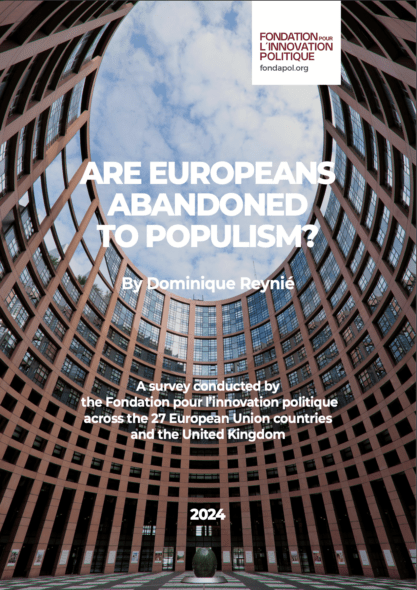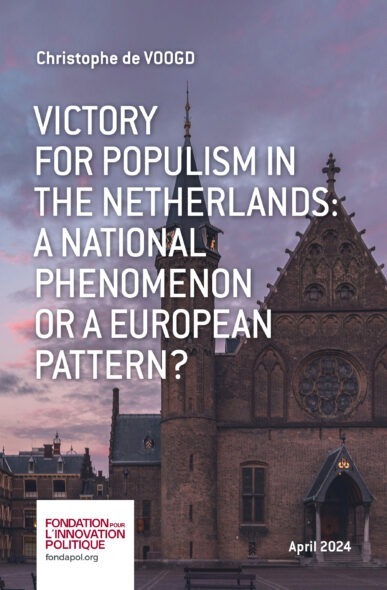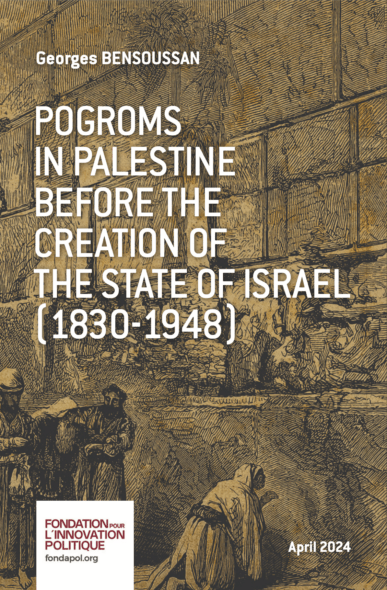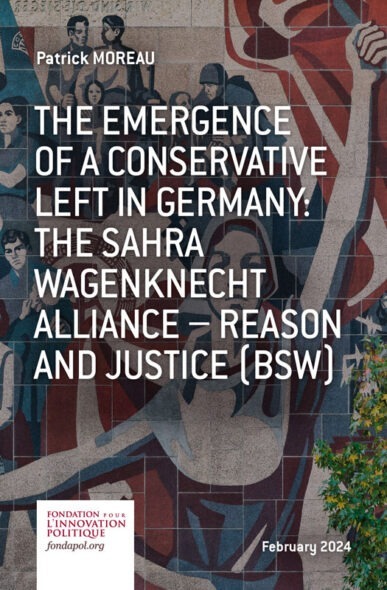Islamist terrorist attacks in the world 1979-2019
An evaluation of Islamist violence in the world (1979-2019)
1979, the critical year
Definition of terrorism
Definition of Islamism
A global database of Islamist terrorist attacks from 1979 to 2019
The reasons why, however, our study underestimates the reality of Islamist violence
The beginnings of transnational Islamist terrorism (1979-2000)
The Soviet-Afghan war, “matrix of contemporary Islamist terrorism”
The 1980s and the emergence of Islamist terrorism
The 1990s and the spread of Islamist terrorism in the Middle East and North Africa
The export of jihad
The turning point of 9/11 (2001-2012)
9/11 and the war on terror
Globalisation of Islamist terrorist attacks
Terrorist migration to social media
The irruption of the Islamic State and Boko Haram (2013-2019)
The Islamic State and the “management of savagery”
The Lake Chad region against Boko Haram’s mass terrorism
The suicide attack, the “martyr” and the terror
Additional data: the estimation of attacks in 2018 and 2019 by an extrapolation of trends
The territories of Islamist terrorism (1979-2019)
The most affected countries (1979-2019)
In conclusion, the main lessons of our study
Summary
Since the Red Army’s invasion of Afghanistan in 1979, the world has been shaken by jihadist terrorism. In forty years, Islamist terrorist attacks have multiplied, reaching as far as the heart of Western countries, New York, Madrid, London, Paris, but also Moscow, etc. By instilling feelings of fear and mistrust, through indiscriminate violence and its repetition, Islamist terrorism fuels or reinforces the demands for authoritarianism and closure that are increasing in democracies.
But have we measured the reality of this violence that worries us so much? Of course, we know that the United States was the scene of the most deadly series of attacks in the history of terrorism on 9/11. We may also know that in Europe France is the most affected country. We can see that Islamist violence strikes more often, even harder, outside the Western world. But we cannot say that we know how to evaluate Islamist violence in this way.
The Fondation pour l’innovation politique wanted to contribute to this evaluation. Since spring 2018, we have been working to quantify Islamist terrorism, to identify the forms it has taken over these decades, to classify the acts it may have inspired or initiated, to estimate the number of its victims, to identify the most deadly organisations and the most affected countries.
To do this, we collected a very large amount of information, to the point of building a large database. It is available in open data on our website data.fondapol.org.
We believe that the mass of information gathered sheds new light on the phenomenon of Islamist violence. It makes it possible to better describe it, to better understand it, to document its severity. Thus, by way of illustration, we can establish that between 1979 and 2019, at least 33,769 Islamist terrorist attacks took place worldwide. They caused the deaths of at least 167,096 people. We can also say that Islamist terrorist attacks account for 18.8% of all attacks worldwide, but that they are responsible for 39.1% of the lives lost due to terrorism; or that, during the years studied, there has been an intensification of this violence and that the deadliest period is the most recent: from 2013 onwards, in our opinion, Islam has become the main cause (63.4%) of deaths due to terrorism in the world. We identify and quantify operating methods and targets. The vision of the phenomenon improves, the image becomes clearer. In this way, we show that the majority of the victims of Islamist terrorism are Muslims (91.2%).
The information gathered is unprecedented. We hope that its content and use will contribute to the knowledge and quality of the debate as well as public decision.
An interactive map of these attacks is available on fondapol.org.
Fondation pour l'innovation politique,
A French think tank for European integration and the free economy.
An evaluation of Islamist violence in the world (1979-2019)
Dominique Reynié, Executive Director of the Fondation pour l’innovation politique
On 3 October 2019, an attack took place on the premises of the Paris Police Headquarters. During a knife attack, three Police officers and an administrative agent were murdered. The murderer was shot dead. He was employed as an administrative assistant at the Intelligence Department of the Paris Police Prefecture (DRPP). However, according to the rules that governed the conduct of our work, we cannot retain in the verified information of our database on Islamist violence the attack itself nor the number of its victims seeing as we do not have the conclusions of the investigation at the time we are completing this study.
“Discours du président de la République en hommage aux victimes de l’attaque à la préfecture de police” [Speech by the President of the Republic in tribute to the victims of the attack on the Police Headquarters], elysee.fr, 8 October 2019.
While 6,291 people were injured on the day of the attacks, thousands more reported physical injuries related to the attacks of 9/11, such as respiratory diseases or cancers, in the years following these events, as evidenced by the World Trade Center Health Registry.
In France, since the first of Mohammed Merah’s attacks on 11 March 2012 and in the recent years, there have been 47 terrorist acts, one deadly attack every two months, killing at least 280 people. During the speech delivered at the Paris Police Headquarters in tribute to the victims of the attack of 3 October 20191, the President of the Republic Emmanuel Macron declared: “The administration and State services alone cannot overcome the Islamist hydra. No, it is the entire nation that must unite, mobilise and act. We will only win if our country, which has overcome so many challenges in history, rises up to fight against this underlying Islamism that corrupts the children of France. A society of vigilance is what we must build. Vigilance, not suspicion that corrupts. Vigilance: attentive listening to others, reasonable awakening of consciences. It is simply knowing how to identify at school, at work, in places of worship, near home, deviations, those small gestures that signal a distance from the laws and values of the Republic”2.
The figure of the hydra indicates a reappearing danger when we thought we could overcome it. Whatever the conclusions of the investigation into the motivations of the killer of 3 October 2019, the observation of the facts proves the President of the Republic right on this point, as the results of our research show.
It was in the United States, less than 20 years ago, on 11 September 2001, that the deadliest series of attacks in the history of terrorism took place, leaving behind 3,001 dead and 16,493 wounded3. In Europe, in forty years, in addition to France, Germany, Austria, Belgium, Bosnia and Herzegovina, Bulgaria, Croatia, Cyprus, Denmark, Spain, Finland, Georgia, Greece, Italy, Norway, the Netherlands, the United Kingdom, Sweden, Switzerland and Russia, have already been hit, sometimes several times. However, it is outside the Western world that countries have suffered Islamist violence more often and much more severely.
1979, the critical year
See Gilles Kepel, Sortir du Les crises en méditerranée et au Moyen-Orient, Gallimard, 2018, p. 23-69.
In his report for the Institut Montaigne, Hakim El Karaoui presents the reasons why, in his opinion, it is possible to consider that the empowerment of jihadism has taken shape in Afghanistan, namely “the emergence of several Islamist groups united by the Afghan conflict, the Afghan Mujahideen‘s financial autonomy, thanks to American and Saudi funding, the effective implementation of jihad for the first time since the end of the 19th century and its theorisation by Muslim Brother Abdullah Azzam” (The Islamist Factory, Institut Montaigne, September 2018, p.19).
Gilles Kepel, Expansion and decline of Islamism, 2nd ed., revised and updated, Gallimard, series “Folio actuel”, 2003, p. 26.
Ibid.
We asked ourselves whether it was possible to truly know the extent of Islamist violence in the world, to make a database of it and to share the results with interested audiences in the form of a database accompanied by this study. To carry out such work, it was necessary first to determine the starting point of the database, to identify the most reliable sources, examine and validate them, then process the data collected, present the main lessons learned and, lastly, make the information collected available to the public.
We decided to start collecting data from 1979 onwards. This year was chosen by most specialists because it reflects the historical failure of Arab nationalism competing with the movements of Islamisation and the affirmation of jihadism4. That same year, a number of events precipitated this development: the Soviet military intervention in Afghanistan, the Iranian revolution, the signing of the Camp David agreements and the hostage-taking of the Great Mosque of Mecca by a group of Islamist fundamentalists in November-December 19795. For Gilles Kepel, what was happening that year was the result of “the fierce struggle between the Saudi monarchy and Khomeini’s Iran”6, but at the same time it was the time of a new indirect confrontation between the USSR and the United States: “The jihad financed in this country [Afghanistan] by the oil-monarchies of the Arabian Peninsula and the CIA is explicitly aimed at inflicting on the Soviet Union […] a ‘Vietnam’ that precipitates its fall. At the Islamic level, its function is also to divert radical militants around the world from the struggle against the American Great Satan – to which Khomeini incites them – and to channel them against the USSR. Afghan jihad has a cardinal importance in the evolution of the Islamist movement around the world. It became the ultimate cause, with which all militants, moderate or radical, identify themselves. It supersedes, in the Arab imagination, the Palestinian cause and symbolises the transition from nationalism to Islamism.7”
Definition of terrorism
“The threatened or actual use of illegal force and violence by a non-state actor to attain a political, economic, religious, or social goal through fear, coercion, or intimidation” (Global Terrorism Database, National Consortium for the Study of Terrorism (START), University of Maryland, Codebook: Inclusion Criteria and Variables, July 2017, 10.
According to this definition, acts of State terrorism are not included in our database.
Like many concepts, terrorism is subject to controversial definitions. In this study, we define “terrorism” as political acts that meet the principle and criteria of the National Consortium for the Study of Terrorism and Responses to Terrorism (START). In this context, a terrorist act is presented as “the threat of the effective use or use of unlawful force and violence by a non-state actor in order to achieve political, economic, religious or social objectives, through fear, coercion or intimidation”8.
This definition is extended to the enumeration of a set of characteristics specifying the nature of the terrorist act:
- it must be intentional and result from a conscious calculation by the perpetrator;
- it must include some level of violence or threat of imminent violence, whether physical or material;
- the perpetrators of the incident must be non-state actors9.
To be included in the database, an event must also meet at least two of the following criteria:
- the violent act must have a political, economic, religious or social objective;
- the act must result from an intention of coercion, intimidation, or be motivated by the desire to spread an economic, political, religious or social message to a wider audience than that represented by the immediate victims; what matters is the intention of those who planned the attack or those who made the decision to carry it out;
- the action must be distinct from activities considered legitimate in time of The act must violate the framework defined by international humanitarian rules, in particular those concerning the prohibition of intentionally targeting civilians or non-combatants.
Our contribution focuses specifically on terrorist acts carried out by organisations or individuals claiming to be Islamists. The criterion defining a terrorist action and according to which “the violent act must pursue a political, economic, religious or social objective” must therefore be specified. It is considered essential to our database and focuses on attacks that have been the subject of an Islamist claim or about which the available information indicates that it has been planned, decided and carried out in the name of Islamism.
Definition of Islamism
Translated from: “[…] une tendance qui consiste à exiger l’application stricte des prescriptions de la loi religieuse ou chari’a dont il considère que certaines avaient été abandonnées, de même que les principes de la foi, par divers gouvernements modernes des pays musulmans, notamment sous l’influence des pays européens, des idéologies occidentales et des mouvements réformistes”, Janine Sourdel and Dominique Sourdel (eds.), Dictionnaire historique de l’islam [Historical Dictionary of Islam], PUF, 1996, 411.
Ibid.
Ibid.
See Mehdi Mozaffari, “What is Islamism? History and Definition of a Concept”, Totalitarian Movements and Political Religions, vol. 8, n°1, March 2007, p. 21.
Edward W. Walker, “ Islam, Islamism and Political Order in Central Asia ”, Journal of International Affairs, vol. 56, n°2, Spring 2003, p. 22, note 1).
Robin Simcox, Hannah Stuart, Houriya Ahmed and Douglas Murray, “Islamist The British Connection”, The Henry Jackson Society and The Centre for Social Cohesion, second edition, 2010, p. XVI.
For historians, “Islamism” is a term “used at the end of the nineteenth century to designate Islam as a religion and civilisation, but which has recently taken a new meaning of militant fundamentalist, traditionalist and proselyte Islam”10. Islamism now refers to “a trend demanding the strict application of the prescriptions of religious or Shari’a law, some of which have been abandoned, as well as the principles of faith, by various modern governments in Muslim countries, particularly under the influence of European countries, Western ideologies and reformist movements”11. As a result of this evolution, the defenders of such a conception of Islam, the “Islamists”, advocate for a jihad that is “on the one hand, in their own country against ‘bad’ Muslims and corrupt rulers in order to establish, if necessary, a purely Islamic state, and on the other hand, more generally, against the secular values that dominate the non-Muslim world”12. The same authors consider that Islamism has many analogies with the Muslim Brotherhood movement13.
There are many other definitions of Islamism, often very detailed. To complete without unduly complicating matters, one can refer in particular to the definition proposed by Edward Walker, because of its relative clarity and conciseness: “By ‘Islamism’, I mean the normative political ideology that has as its core program the establishment of Islam as a state religion and the implementation of Islamic law (shari’a). Militant Islamism, then, is any form of Islamism that advocates the use of violence to achieve Islamist objectives. This same distinction is made by Islamists themselves, who refer to ‘Parties of the Islamic Call’, or al-da’wa al Islamiyya (i.e., Islamist groups that do not advocate violence) on the one hand, and ‘Parties of the Muslim Revolution’, or al-thawra al-Islamiyya (i.e., Islamist groups that do advocate violence) on the other hand14.”
Acknowledging that there are no universally accepted definitions of Islamism and terrorism, some researchers characterise it as an ideology whose key tenets include:
- Belief that Islam is not only a religion, but also a holistic sociopolitical system;
- Advocacy of Sharia (Islamic) law as divine state law;
- Belief that a transnational Muslim community, known as the Ummah, should unite as a political bloc;
- Advocacy of an ‘Islamic’ state, or Caliphate, within which sovereignty belongs to God.15
A global database of Islamist terrorist attacks from 1979 to 2019
On 28 April 2019, the German newspaper Welt am Sonntag published a list of Islamist terrorist attacks. This list covers a shorter period, from 11 September 2001 to 28 April 2019. Until 2017, the data are extracted from the Global Terrorism For the years 2018 and 2019, the newspaper constructed its own database. Our data differ from those of the Welt am Sonntag in at least three respects: first, we cover a period of forty years instead of eighteen years, which allows us to follow the evolution of Islamist terrorism, in particular by showcasing a phenomenon of globalisation; second, Welt am Sonntag has chosen to count only attacks that have killed at least twelve people, while we have recorded all identifiable attacks; thirdly, Welt am Sonntag focused on attacks by the main terrorist groups (Abdullah-Azzam Brigade, Asaib Ahl ab-Haqq, Abu Sayyaf, Ansar al-Din, Allied Democratic Forces, Algerian jihadists, Ahrar al-Sham, Ansar al-Islam, Al-Ittihaad al-Islami, Al-Islah Party, Aisha-Brigade, Al-Aksa Martyrs’ Brigade, Al-Muaqioon-Biddam Brigade, Ansar-Al-Din-Front, Al-Qaeda, Arakan Rohingya Salvation Army, Ansar al-Sunna, al-Shabaab, Ansar al-Sharia, Ansar al-Tawhid, Ansar ul-Islam, Boko Haram, Sunni Jihadist Movement of Iran, Deccan Mujahideen, Religious Guardians, Armed Islamic Group, Salafist Group for Preaching and Combat, Hezbollah, Hizb-i-Islami, Harkatul Jihad-e-Islami, Hakkani Network, Halqa-e-Mehsud, Hisbul Mujahideen, Hamas, Houthis, Hayat Tahrir al-Sham, Islamic Jihad of Uzbekistan, Islamic Front, Indian Mujahideen, Islamic Party of Turkestan, Jaish al-Adl, Jaish-al-Islam, Jamaat al-Tawhid wal-Jihad, Jaish-e-Mohammad, Jaish al-Fatah, Jaish-i-Islam, Jemaah Islamiya, Jund al-Khilafah, Jamiat ul-Mujahedin, Jama’at Nasr al-Islam wal Muslimin, Jundallah, Jundallah Pakistan, Jaljala Army, Kataib Hezbollah, Lashkar-e-Jhangvi, Lashkar-e-Omar, Lashkar-e-Taiba, Lashkar-e-Islam, Mujahideen Ansar, Mahaz-e-e-Inquilab, Moro Islamic Liberation Front, Moro National Liberation Front, Movement for Tawheed and Jihad in West Africa, Mujahedeen Shura Council, Mukhtar Army, Front al Nosrah, Students Islamic Movement of India, Sipah-i-Mohammed, Salafia Jihadia, Shura of the Derna Mujahideen, Special Purpose Islamic Regiment, Shura of the Benghazi Revolutionaries, Taliban, Tehrik-e-Taliban Islami, Tehrik-e-Taliban Pakistan, United Jihad Council); while our database lists all Islamist attacks as accurately as possible. Thus, in addition to attacks by the best-known groups, we also take into account attacks by individuals or small groups claiming to be Islamists without belonging to a particularly well- known organisation. See “18 Jahre Terror”, Welt am Sonntag, nº. 17, April 28, 2019, pp. 12-14.
We can mention, for example, the database made available by the French newspaper Le Monde on the attacks committed by the Islamic State from 2014 to 2016 or the New York Times’.
Global Terrorism Database, National Consortium for the Study of Terrorism (START), University of Maryland.
The Global Terrorism Database does not provide any information for 1993.
Since October 2019, the year 2018 is available on the GTD. We did not have the opportunity to compare them with our own data for these two years 2018 and 2019, especially since the GTD is now subject to a more restrictive licensing system.
It is within the framework of these definitions that we have conceived this work and that we propose here the result in the form of a database listing the Islamist terrorist attacks perpetrated in the world since 27 December 1979. The data included in our database does not extend beyond 31 August 2019, given the time required to validate and process the information collected. Indeed, while the attacks in Western countries have considerable visibility, due to the greater impact that violence can have in more peaceful societies, their ability to produce reliable data quickly and a particularly dense media presence, the same cannot be said for attacks that take place, much more often, in other parts of the world where all identification and intelligence processes become longer but cannot be as effective. Therefore, the validation and classification of relevant events requires work that goes beyond the time we had to define in order to make this publication possible.
To carry out our research, we used three types of sources: the collection of information on attacks since 1979 via search engines, the cross-referencing of existing databases and academic research. There are indeed various databases on terrorist attacks in general and Islamist attacks in particular16. All the databases in circulation were useful to us in confirming or enriching the work we were completing17. However, most of the databases available are very incomplete or unevenly documented. In some cases, information may be abundant about a country, region, year or period, usually very short, then very little or non-existent for another year or country. This can be seen on Wikipedia, where data by year or theme are available but very incomplete, fragmented and in a form that does not allow statistical processing. That is why our initial source was the Global Terrorism Database (GTD) developed by the University of Maryland in the United States18. This gigantic database compiles terrorist attacks between 1970 and 2017. The value of this set is to identify terrorist attacks regardless of their motivation. This abundance was also the main challenge for us, since we had to extract Islamist attacks from the 171,787 attacks recorded worldwide from 1979 to 2017. We therefore carried out a selection, verification and classification of the data contained in the GTD.
We then had to supplement it with our own information, particularly for the year 199319. We worked without the GTD for the years 2018 and 2019 since data for these years were not provided20.
For each Islamist terrorist attack in our database, we have provided the following information:
- the date;
- the location of the attack: country, city, and exact location when possible to identify it;
- the number of confirmed deaths and injuries, including attackers; it is important to note here that the number of people wounded is clearly very underestimated by the available information;
- the perpetrator(s) of the attack;
- the type(s) of target(s);
- the type(s) of attack(s) in question;
- the type(s) of weapon(s)
The reasons why, however, our study underestimates the reality of Islamist violence
It is clearly impossible to claim to propose an exhaustive database of Islamist terrorist attacks committed in the world between 1979 and 2019, for a number of reasons detailed below.
a/ A number of attacks have not been recorded. No matter the efforts made, it is certain that a significant number of attacks falling under the Islamist category could not be recorded, either over the entire period concerned or for the years 1993, 2018 and 2019.
b/ A number of attacks do not appear in our “retained estimate” when religious motivation is not clearly predominant in a combination involving another determination. Islamist terrorism takes place in singular and complex contexts that some- times make it difficult to collect reliable data. This is particularly the case in situations of war, civil or international, independentist or separatist struggles and territorial conflicts that persist over long periods of time, where causalities are shifting or inextricable, as in the case of the Palestinian conflict, while in a completely different context, in Thailand for example, a separatist movement has led a Muslim minority to get involved with weapons in the name of objectives that can achieve, beyond political demands, a religious dimension.
c/ Islamist motivation is not always identified. Available data do not always allow news agencies to attribute the attack to the Islamist cause, especially if the country affected by the attack is characterised by weak administrative structures. The absence of claim of responsability can increase the likelihood that an attack will not even be recorded by agencies or that this information will not reach the press.
d/ The number of deferred deaths is practically unknown. However, it is certainly significant. Since victims who succumb to their injuries after an attack are almost never mentioned in the available information, it is impossible to know their exact number. It is therefore also impossible to integrate these deaths into our database in a reliable way. Thus, according to our database, we record at least 167,096 deaths and 151,431 people wounded, which is less than the number of deaths.
However, if we consider three cases of attacks, each carried out with different means, in two countries where the quality of information is excellent, we observe a completely opposite ratio between the number of deaths and the number of people wounded: in the United States, there were five times as many people wounded (16,493) than killed (3,001) in the 9/11 attacks; in France, there were three times as many people wounded (413) than killed (137) in the 13 November 2015 attacks; in Nice, in the 14 July 2016 attack, there were five times as many people wounded (458) than killed (87). This information leads us to believe that the number of people wounded is much higher than that in our database. Certainly, developing countries, which are the countries where most attacks take place, do not have the same capacity to identify and care for people injured in an attack. Some of the injured are probably not even counted, while others die from their injuries after a certain period of time due to the inadequacy or fragility of relief systems and health institutions. If we applied the ratios of the three sample attacks to the number of casualties in our database (151,431), we would have to adjust this figure by multiplying it by three (454,293) or five times away (757,155).
e/ For these four reasons, we propose two types of quantification of Islamist violence, in the form of a “retained estimate” and a “possible estimate”. The “retained estimate” results from our database of attacks during the period 1979-2019, that were clearly motivated by an Islamist agenda. The “possible estimate” results from the identification of attacks that could be qualified as Islamist, including certain terrorist acts that are also based on separatist, political or social logic, which make it more difficult to attribute them to an exclusively or mainly Islamist motivation. In all cases, the number of victims, dead or injured, is significantly lower than a reality that cannot be more precisely known.
We have recorded 33,769 Islamist attacks that killed at least 167,096 people between 1979 and 2019.
The years 2018 and 2019 have the least amount of information provided. For 2018, we counted 1,606 Islamist terrorist attacks (8,715 deaths) and, for the period between 1 January and 31 August 2019, 826 Islamist attacks (4,953 deaths). The lower number of attacks in 2018 and 2019 compared to previous years, although still significant, does not mean a decrease in Islamist violence but results from the state of our database, which has to be consolidated.
However, the considerable volume of our data allows for a simple extrapolation exercise which is to replace the information collected for the years 2018 and 2019 with an annual mean of Islamist terrorist attacks and the number of their victims. If we calculate these averages using the most recent years, those corresponding to the 2001-2017 cycle, we obtain an average annual number of 1,715 attacks causing the deaths of 8,624 people. Assigned to 2018 and 2019, these two results make it possible to estimate the number of Islamist terrorist attacks and their victims for the period 1979-2019.
Our research began in the spring of 2018. The study we are publishing here is based on the database we have developed, available as open data on data.fondapol.org. In the following analyses, we first present the evolution of Islamist terrorism from 1979 to the present day; second, we propose an interpretation of the data according to the regions of the world and the countries affected by Islamist violence.
The accuracy of the figures does not imply such a detailed knowledge of the observed reality; the degree of accuracy results from the calculation operations applied to the database. We could only reproduce the exact result of these operations.
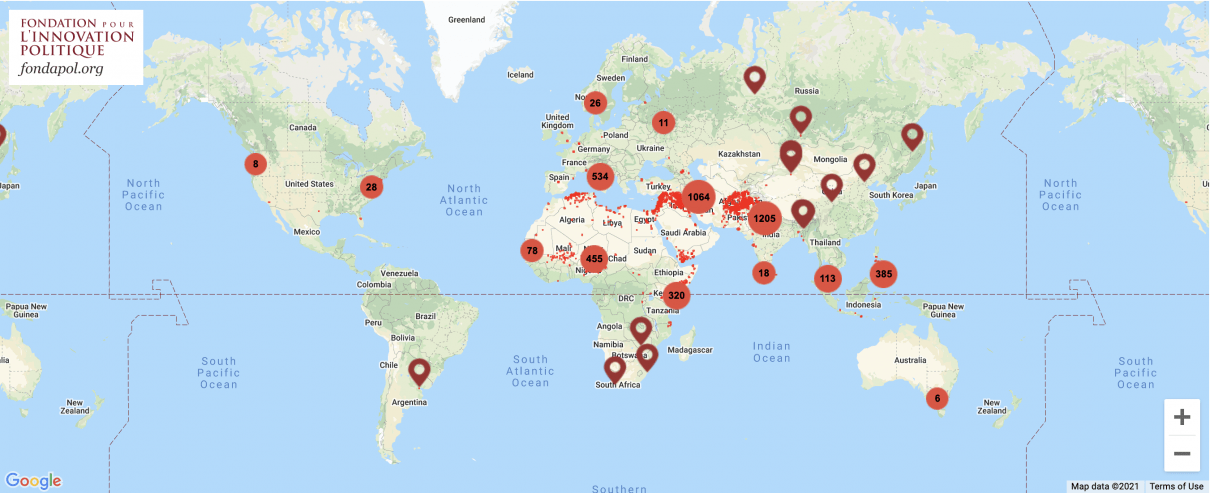
The beginnings of transnational Islamist terrorism (1979-2000)
This work does not aim to shed light on the foundations of Islamism or to discuss the origins and justifications, in the context of Islam, of the use of violence and violence of a terrorist nature in particular. In a different way, we consider that our contribution lies in the information that can be obtained from the exploitation of a consolidated database and the analyses to which it can give rise. However, in order to understand the value of the data shared here, it is necessary to briefly recall the developments in Islamist terrorism since 1979.
See Mohamed Louizi, Liberér islam de l’islamisme, Fondation pour l’innovation politique, January 2018 (); Mohamed Sifaoui, Taqiyya! Comment les Frères musulmans veulent infiltrer la France, L’Observatoire, 2019; or Malik Bezouh, Crise de la conscience arabo-musulmane, Fondation pour l’innovation politique, September 2015.
Until the mid-1970s, Islamism had little influence in the Middle East and North Africa. In the wake of decolonisation and the rejection of Western imperialism, the new States of the region affirm a nationalist and pan-Arab vision promoted by leaders such as Nasser or Boumediene and by movements such as Ba’ath, in Syria and Iraq, or the Palestine Liberation Organisation (PLO) in Palestine. Islamist organisations are firmly contained or severely repressed, as Nasser did in Egypt with the Muslim Brotherhood. Founded in 1928 by Hassan el-Banna, the Muslim Brotherhood was established with the aim of restoring the political Islam that had disappeared with the abolition of the Ottoman Caliphate proclaimed by Atatürk in 1924.
At the end of the 1970s, the Islamist claim was strengthened1. The increase in social inequalities and corruption of the elites were denounced. Islamist movements were trying to embody a political alternative to existing dictatorships or are engaging in violent actions, as in Syria, where the Muslim Brotherhood launched an armed struggle against the Baathist regime of Hafez el-Assad. These movements of Islamisation in Middle Eastern societies flourished all the more as Arab nationalism began to falter then collapsed. At the end of the decade, in 1979, a window of opportunity opened up for Islamists in the Middle East and North Africa.
The Soviet-Afghan war, “matrix of contemporary Islamist terrorism”
See Gilles Kepel, “Le terrorisme islamiste est né en Afghanistan”, remarks collected by Héloïse Kolebka, L’Histoire, n°293, December 2004, p. 18-19.
The year 1979 was a pivotal year, the scene of several important events, including the Iranian revolution and the invasion of Afghanistan by the USSR. The Russian military operation precipitated the emergence of a new Islamism. At the same time, in Iran, the opposition led by the Shiite clergy, due to the context of intense social protest, forced the Shah to flee the country (16 January 1979). On 1 February 1979, Ruhollah Khomeyni came to power. He initiated the transformation of Iran’s imperial regime, accused of “Westernisation”, into an Islamic republic. In the wake of the Iranian revolution, Shia groups advocating armed struggle were formed. Among them is the Lebanese Hezbollah, created in 1982. Shia ideology is affirmed in the context of the process of Islamisation of the Middle East where it competes with Sunni legitimacy.
In Afghanistan, the Soviet invasion initiates the conflict which will be considered the matrix of contemporary Islamist terrorism2. Jihad is supported by Saudi Arabia, Algeria and Egypt. Jihadists who reach Afghanistan become “mujahideen”; they are seen as the liberators of a “land of Islam” (dar al-islam).
The 1980s and the emergence of Islamist terrorism
With 354 attacks, which cost the lives of 1,447 people, the 1980s are the least deadly years compared to the decades that followed. The emergence of Islamist terrorism is visible from the years 1980-1983 which correspond to the Muslim Brotherhood’s activism in Syria, in the midst of an uprising against the government of Hafez el-Assad.
From 1980 to 1982, there were 69 attacks on Syrian territory, representing nearly two-thirds (63.3%) of all Islamist attacks listed in the world during these three years. Attacks ceased after the repression of the Muslim Brotherhood movement, including during the Hama massacres by the Syrian army in 1982.
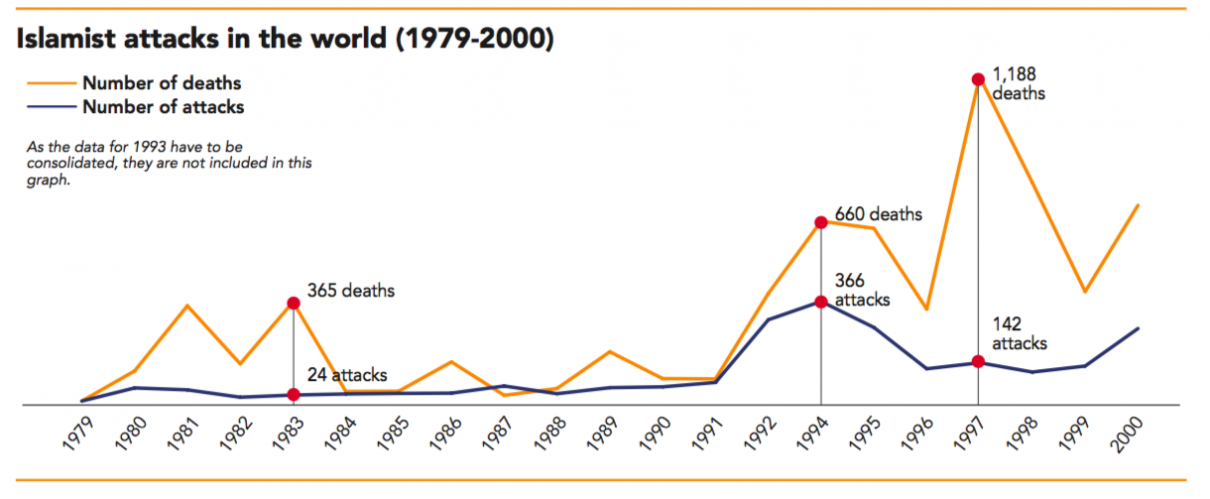
From 1980 to 1989, the country most affected by Islamist terrorism is Lebanon, with 133 attacks, which caused at least 515 deaths. In the grips of a civil war since 1975, the country has been experiencing the rise of small terrorist groups. This unstable national context and Israel’s invasion of southern Lebanon in 1982 promote, the same year, the emergence of Hezbollah. A year later, the Shia organisation triggered a series of attacks on foreign institutions. An Italian patrol was hit on 15 March 1983, although no lives were lost, but on 18 April a new attack hit the United States Embassy in Beirut, resulting in the deaths of 63 people. At the end of the same year, on 23 October, an American base and a French patrol were terribly hit by an attack in which 299 people lost their lives. Hezbollah’s terrorist activism is particularly intense in Lebanon, where it committed 276 attacks from 1983 to 2000, but it is not limited to this. In all, by integrating the other affected countries, Hezbollah is responsible for 341 attacks from 1983 to 2000, kil- ling 1,110 people. Saudi Arabia, Argentina, Cyprus, Denmark, Egypt, Greece, Israel, Israel, the Kuwait and Tunisia are among the affected countries.
In September 1986, Paris suffered a series of six attacks, including the one on 17 September, rue de Rennes, in front of a store, which killed 7 people and injured 55.
These attacks were claimed by the Solidarity Committee with Arab political prisoners and the Near East, on behalf of the Lebanese Hezbollah.
The Lebanese organisation is also considered responsible for the two attacks on the Israeli Embassy on 17 March 1992 in Buenos Aires (30 dead, 220 wounded), as well as the attack of 18 July 1994 on a Jewish association, also in Buenos Aires (85 dead, 236 injured). Over the whole 1979-2019 period, Argentina remains the only country in South America affected by Islamist terrorism, with three attacks.
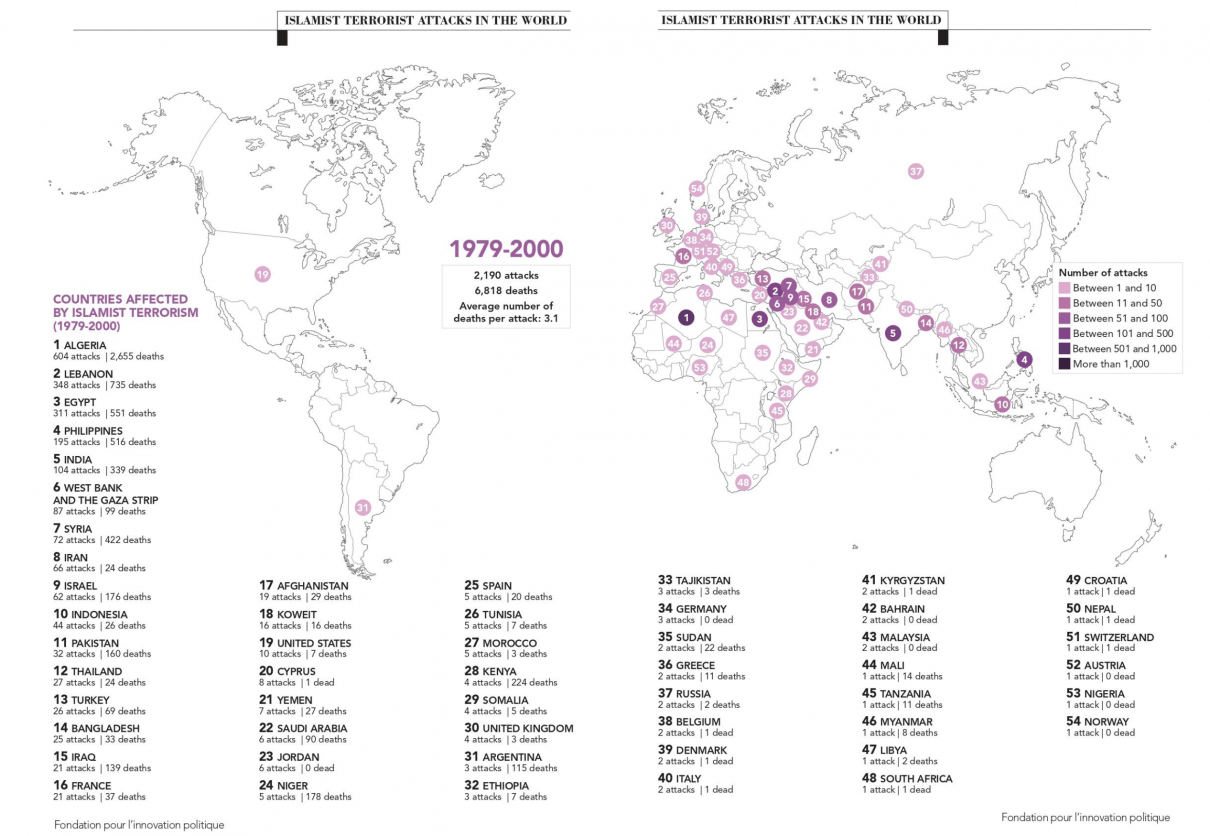
The 1990s and the spread of Islamist terrorism in the Middle East and North Africa
The withdrawal of the Red Army from Kabul on 5 February 1989 galvanised Islamist mobilisation, already stimulated in 1987 by the creation of Al-Qaeda, by Abdullah Azzam and Osama bin Laden. The globalisation of the jihadist struggle began then. The discourse is mainly based on the idea of a unified Muslim community (ummah) claiming autonomy from the ethnic, national and cultural specificities of each nationality. The objective is to establish the Caliphate and the exemplary prophetic city, which must also be extended to non-Muslim countries. The empowerment of the jihadist discourse in relation to classical, nationalist and political referents is not the hallmark of Al-Qaeda. It is taken up by all Muslims who came to Afghanistan to take part in the violent action. Following the Soviet withdrawal, these mujahideen returned to their countries of origin and spread the ideas of Jihadist Salafism there. Thus, in the 1990s, an increasing number of countries, particularly in the Middle East, were directly affected by Islamist violence.
In Algeria, a number of jihadists gathered in mili- tant groups since the beginning of the 1991-2002 civil war. The victory of the Islamic Salvation Front (FIS) in the 1990 municipal elections and the 1991 parliamentary elections, followed by the cancellation of these elections by the Algerian army and the resignation of President Chadli Bendjedid, triggered a “black decade”. Military and Islamist groups engaged in a terrifying struggle for power. The confrontation devastated the country. From 1990 to 1999, Algeria was the country that was hit the hardest by Islamist terrorism. There were 542 attacks, or more than a third (34.6%) of the attacks recorded worldwide during this decade by our database; there were at least 2,390 deaths, representing more than half (51.4%) of the victims of Islamist terrorism in the world between 1990 and 1999. The violence reached its peak in 1997: 967 people were killed following the parliamentary elections won by the Rassemblement national démocratique (RDN), supported by the army.
During this “black decade”, religious figures and institutions were particularly affected, particularly Christians of foreign nationalities: twelve Croatian tourists were murdered on 14 December 1993, two Spanish nuns were killed on 23 October 1994 and seven French monks from Tibhirine were kidnapped and murdered in the spring of 1996.
See Amr Hamzawy and Sarah Grebowski, “From Violence to Moderation. Al-Jama’a al-Islamiya and al-Jihad”, Carnegie Papers, n°20, April 2010.
Gilles Kepel, Sortir du chaos…, op. cit., p. 102. 5.
Ibid., p. 99.
In Egypt, on the eve of the 2000s, the Islamist landscape was structured by two movements: al-Jihad and al-Gama’a al-Islamiyya. The objective of these two organisations was the establishment of an Islamic State, and the means to achieve this was terrorism3. In the 1990s, al-Gama’a al-Islamiyya launched 257 insurgent attacks against the government, killing 489 people.
In the Middle East, the 1990s were marked by the Islamisation of the Israeli-Palestinian conflict. A transfer of power of sorts took place to the benefit of Hamas, a Palestinian Islamist movement born in 1987 at the beginning of the first Intifada, and Types of attacks in the West Bank and the Gaza Strip (1979-2000) to the detriment of the PLO, which came from the Arab nationalist movement. This evolution led to a change in the Israeli-Palestinian conflict. In 1992, 417 leaders and activists of Hamas were arrested and taken to southern Lebanon, in the village of Marj al-Zuhur, after the assassination of an Israeli officer. A resolution of the Council of UN security necessitated their repatriation.
This event is analysed by Gilles Kepel as “the transition which gave Hamas parity with the PLO, if not primacy, for the incarnation of the Palestinian cause, and consequently the Islamisation of its Arab and universal image4“. Beyond the political vicissitudes on Palestinian territory, “the increase in suicide attacks – in the face of the hardening of successive governments of Mr. Netanyahu and the intensification of colonisation – can be considered as the model for the mirror of which the international jihadism of Al-Qaeda would develop its preferred mode of action5“.
In our database, we clearly observe an increase in the number of attacks affecting the Israeli and Palestinian territories from the beginning of the 1990s. Terrorist attacks are largely incriminating to Hamas but also to the Palestinian Islamic Jihad Group (PIJ). Between 1979 and 2000, of the 62 attacks recorded on the ground, 29 were claimed by Hamas and 13 by the PIJ. Out of 86 attacks in the West Bank and the Gaza Strip, 65 were claimed by Hamas and 12 by the PIJ.
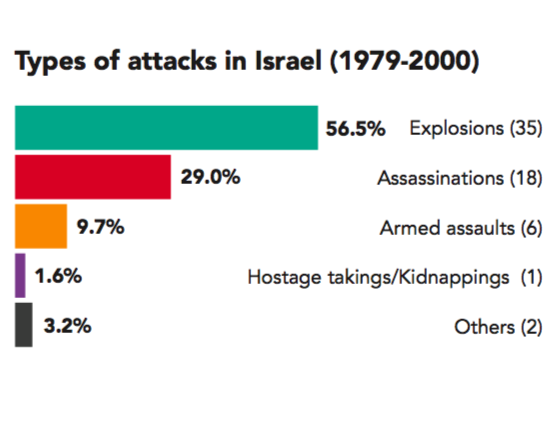
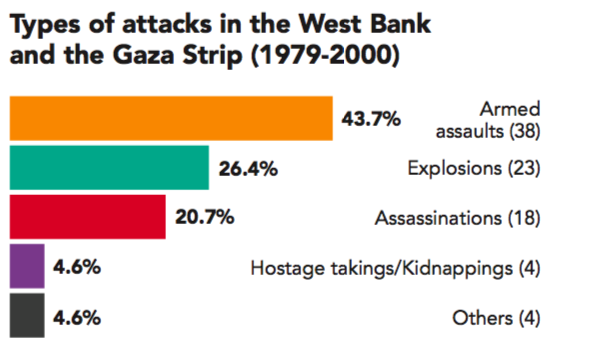
The export of jihad
Islamist violence has been on the rise in the Middle East and in North Africa from the 1980s onwards, and other regions of the world are also becoming hosts to this jihad, particularly Southeast Asia (Philippines), South Asia (India) and Europe.
See Dominique Thomas, Le La voix du djihad, Michalon, 2003, p. 70.
Ibid., p. 62. On Salafo Jihadist activism in the United Kingdom, see also Dominique Reynié, Les Nouveaux Populismes, Paris, Fayard/Pluriel, 2013, in particular the second part (“The conflict of identities”) and in particular its chapter 3, “Sharia law in Europe? “, p. 97 sqq.
Rapid empowerment and the increasing power of Islamism eventually raise fears of countries that have nevertheless worked for this movement or who used it for domestic political reasons or international relations. Thus, in the face of the Islamist threat, Saudi Arabia and Algeria have engaged in relentless repression. This is also the case for Egypt and Syria. In a decade, Salafists have changed categories: firstly admired as “freedom fighters”, they were then denounced as “fugitives”6.
This regional context forced many jihadists into exile: some, having returned from Afghanistan, became political refugees, often with the aim of exporting their Islamist struggle to new territories, including those that are not predominantly Muslim. They sought asylum in Europe. In the 1990s, these territories of settlement and conquest were first England and France. London thus became a hub for Salafo Jihadist activism in Europe7. Between July and October 1995, France was hit by a wave of Islamist attacks related to the Algerian context: on 25 July 1995 an attack in the Parisian metro resulted in the deaths of 7 people and 86 people wounded.
Asia was also hit hard between 1979 and 2000, particularly in the south and southeast. According to our database, we record the first Islamist attack in India in 1986. The phenomenon remained sporadic until 1990. In that year, 14 attacks were carried out under the leadership of the Hizbul Mujahideen (HM) group and its supporters. The action of this Islamist group was rooted in the conflict between India and Pakistan over the border region of Jammu and Kashmir, but if the group wanted the region to be integrated into Pakistan, it was also campaigning for the establishment of a caliphate in the world.
The landscape of Islamist terrorism in India is frag- mented: a number of groups revolve around the issue of independence, including Allah’s Tigers (“Tigers of Allah”), the Muslim Brotherhood, Harkat ul-Ansar and Jamaat-e-Islami. Between 1979 and 2000, most attacks (78.8%) were concentrated in Jammu and Kashmir. Since 2000 and the creation of the terrorist group Jaish-e-Mohammed (JeM), attacks have been both more numerous and more deadly (25 attacks and 126 deaths in 2000, 42 attacks and 200 deaths in 2001). These years also saw the Pakistani Taliban (Lashkar-e-Taiba) conducting terrorist campaigns in India.
In the Philippines, Islamist terrorism is deployed as part of the separatist struggle of the Moro people, a Muslim minority in the south of the country. One of the main terrorist groups in the region, the Abu Sayyaf Group (ASG), founded in 1991 by Abdurajak Abubakar Janjalani, drew its inspiration from Islamist movements in the Middle East. The first demons- tration of this terrorist movement occurred on 7 September 1986, when the Moro Islamic Liberation Front (MILF) attacked a Catholic church and a marriage ceremony in Salvador, on the island of Mindanao, killing 20 people and injuring 186. The group launched an attack on 15 January 1987 in the Manila metro, the capital, killing 8 people. In 1994, after an eclipse of sorts, the Abu Sayyaf Group (ASG) carried out 7 attacks in the south of the country. It later became one of the main actors of Islamist terrorism in the Philippines in the following decades.
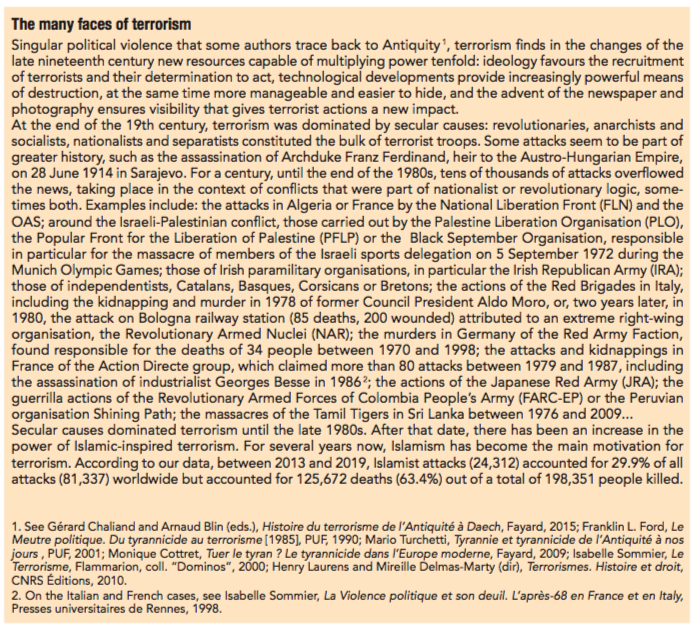

The turning point of 9/11 (2001-2012)
The attacks of 9/11 2001 perpetrated by Al-Qaeda on U.S. soil were the deadliest terrorist attacks in history, with a total of 3,001 dead and 16,493 wounded. On that day, two hijacked airliners were launched against the towers of the World Trade Center in New York. A third aircraft had been directed at the Pentagon in Washington. On board the fourth hijacked aircraft, it was a passenger revolt that defeated the terrorists’ plan, as the aircraft crashed in the countryside in Pennsylvania. The live and global broadcasting of this dramatic and spectacular event also marked the beginning of a new era in the media coverage of terrorism. In addition to the deferred information intended for specific audiences, immediate and comprehensive information is now available. This new public space profoundly affects the work of traditional media (television, press and radio). The advent of social media and smartphones is opening its doors of mass communication to countless new players, starting with terrorist organisations.
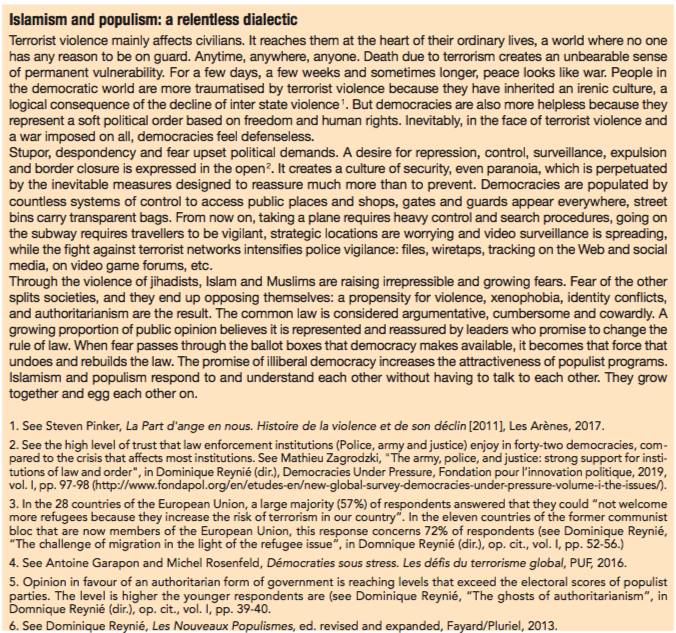
9/11 and the war on terror
According to a survey conducted by the Fondation pour l’innovation politique and the Fondation pour la Mémoire de la Shoah, of the seventeen events proposed, half of the young people surveyed (47%) cite the attacks of 9/11 as one of the three most significant events (see Future Memories, Fondation pour l’innovation politique and the Fondation pour la Mémoire de la Shoah, January 2015.
The attacks of 9/11 have had a significant impact that changed the geopolitics of the Middle East1. Qualified by George W. Bush’s administration as the “war on terror”, the American response was brisk. On 7 October 2001, the United States launched a major offensive against the Taliban regime in Afghanistan, accused of having supported Al-Qaeda. A year and a half later, on March 20, 2003, the American army invaded Iraq, in order to overthrow Saddam Hussein’s regime in the prospect of “democratising the Middle East”. Despite overwhelming military victories, the United States is failing to restore peace, or to eradicate Islamism. Confronted with the machine of American war in the long term, Islamists organised themselves, by acquiring an international dimension that keeps being reaffirmed. Between 2001 and 2012, the number of attacks and victims have increased in a spectular way, notably due to the attacks perpetrated by Taliban fundamentalists.
Their movement has been spreading in Afghanistan and in Pakistan since 1994. Two years later, they overthrew the government in place when Kabul was taken over. They established the regime of the Islamic Emirate from Afghanistan, headed by Mohammad Omar. In the years that followed, the Taliban persecuted minorities, established a well-founded regime on the strict application of Sharia law and welcomed numerous wanted jihadists, including the leader of Al-Qaeda, Osama bin Laden. In a few years, Afghanistan became a home for Islamic extremists from all over the world.
After the attacks of 9/11, the Taliban were driven out of power by an international coalition led by the Americans. From this moment on, there was an exponential increase the number of attacks and the number of victims, in particular among international forces or members of the Afghan government. We went from 4 attacks and 153 deaths in the country in 2001 to 829 attacks and 2,604 deaths in 2012. In total, between 2001 and 2012, 2,536 attacks took place on Afghan soil, killing at least 8,054 people. This represents 30.7% of the total number of Islamist attacks worldwide between 2001 and 2012. The Taliban were responsible for most (95.2%) of these attacks.
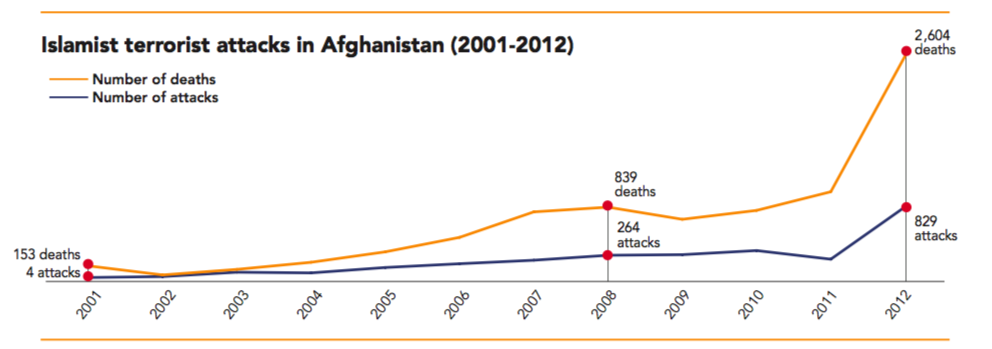
In Pakistan, we also witnessed the rise of groups multiplying terrorist acts between 2001 and 2012, with 1,009 attacks and 4,997 deaths. Very present in this country, the Taliban organised themselves from 2007 under the name Tehrik-e-Taliban Pakistan (TTP); they were responsible for nearly three-quarters of the (71.2%) of the terrorist violence over this period (2001-2012). Other Islamist groups are also active, such as Lashkar-e-Jhangvi (56 attacks, 386 deaths) or Lashkar-e-Islam (64 attacks, 115 deaths). In 2007, two terrorist attacks led by Al-Qaeda and its allies left their mark on the landscape of the country’s politics: on 18 October, an attack against a crowd gathered to welcome the former Prime Minister Benazir Bhutto, returning from exile, caused the death of 141 people and wounded 250. On 27 December, she was murdered in turn, victim of a suicide attack that killed 20 people and wounded more than a hundred.
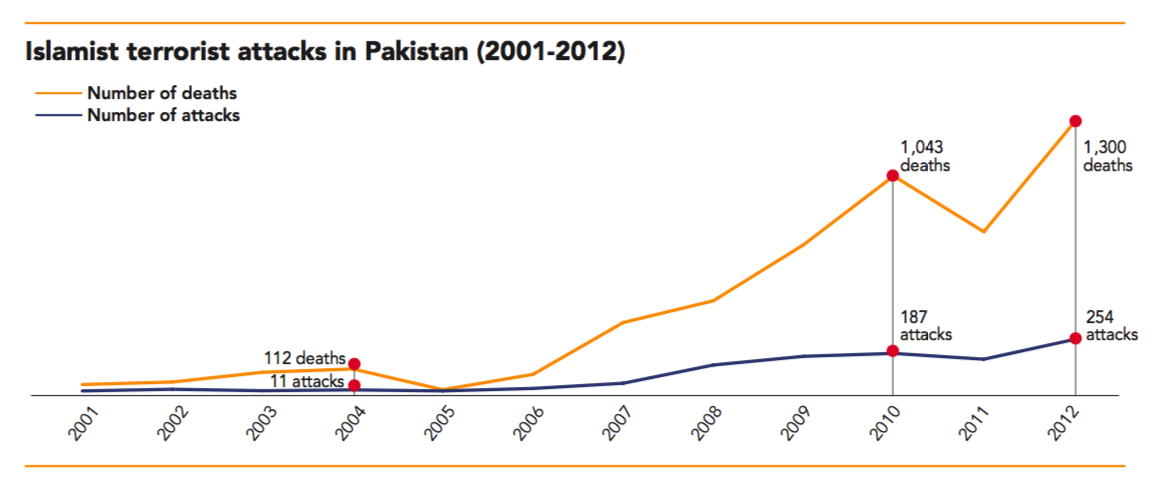
Between 2001 and 2012, Iraq was the third largest country most affected by Islamist terrorism, with 914 attacks. Particularly violent, these attacks caused the deaths of 8,534 people, with on average 9.3 people killed per terrorist action. By comparison, in the world during the same period, an attack killed an average of 4.6 people. The fight against foreign interference is a key reason for violence by Islamists. From the moment on 19 August 2003, the car bomb attack against the Canal Hotel, UN headquarters in Baghdad, killed 22 people. The year 2004 saw a series of terrorist attacks targeting coalition member countries in Iraq, with 9 attacks against personnel at military bases, checkpoints and patrols of the Multi-National Force-Iraq (MNF-I). At the same time, the development of hostage takings/kidnappings became more common to terrorist actions: while we do not record any hostage takings or kidnappings in 2001, 2002 and 2003, there were 27 in 2004, largely aimed at civilians from countries militarily deployed in Iraq (5 Americans, 4 Japanese, 3 South Koreans, 1 Bulgarian, 1 Canadian, and 1 Italian). Among the countries involved in the war, the United States was greatly affected: between 2001 and 2012, in Iraq, 34 attacks targeted Americans, including 15 during the year 2004
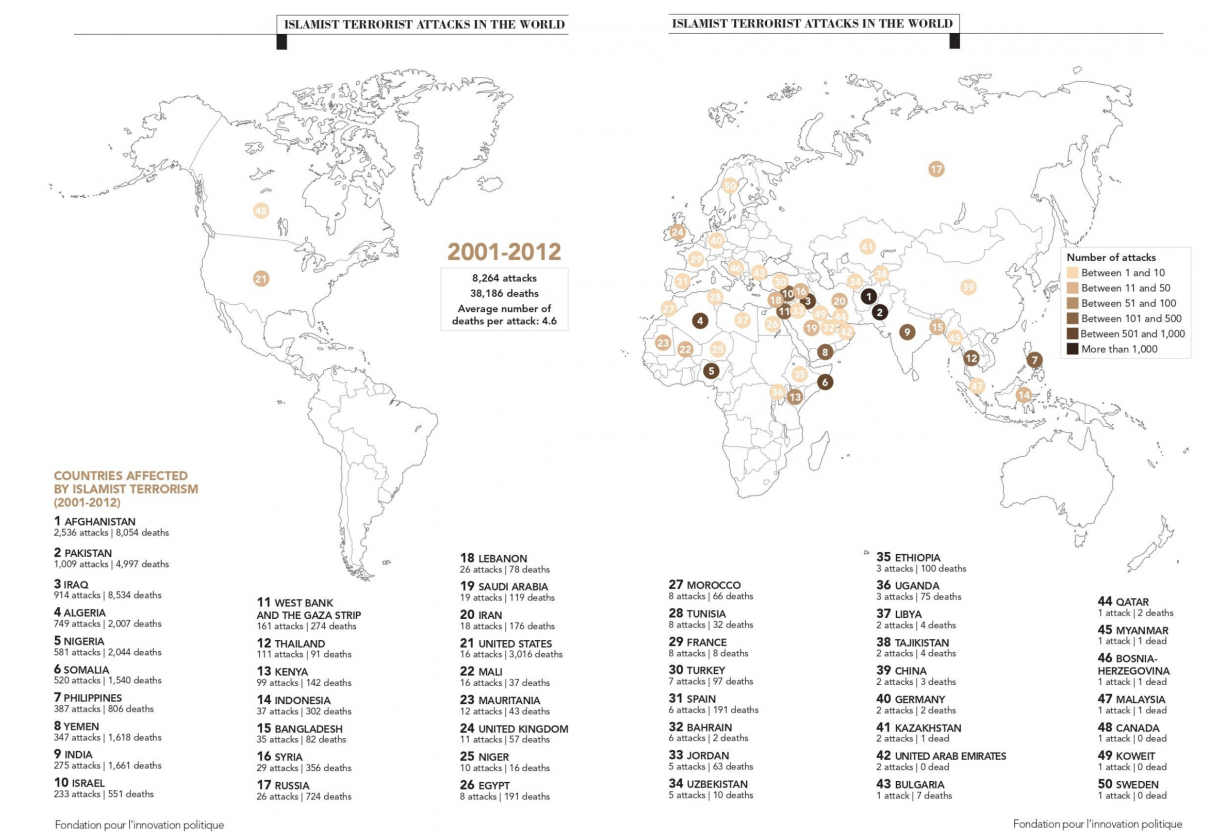
Globalisation of Islamist terrorist attacks
Between 2001 and 2012, an increase in Islamist attacks is observable in several geographical areas in the world. Compared to the previous period (1979- 2000), there was a sharp increase in the number of terrorist attacks, with 8,264 attacks (compared to a total of 2,190 between 1979 and 2000) and 38,186 deaths (compared to a total of 6,818 between 1979 and 2000). This dramatic increase is partly due to the globalisation of jihad, facilitated by the acceleration of the circulation of people and ideas.
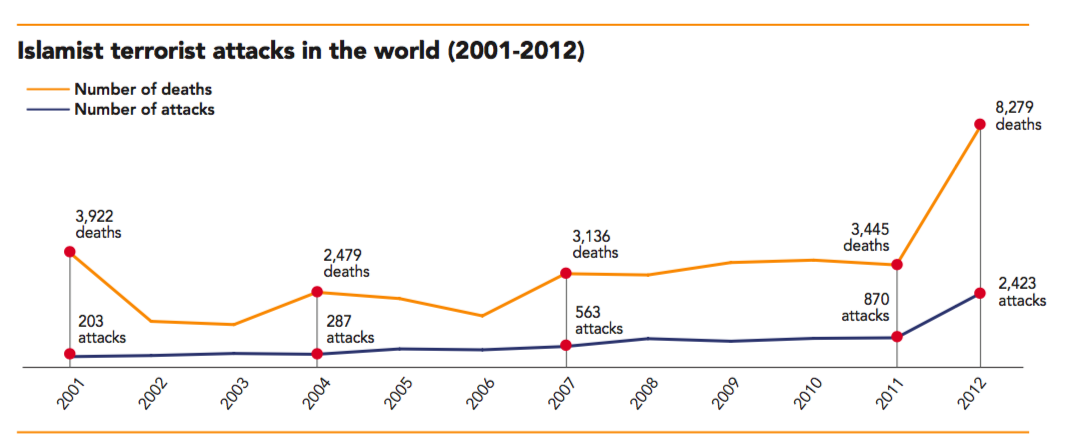
Gilles Kepel, Sortir du chaos. Les crises en Méditerranée et au Moyen-Orient, Gallimard, 2018, 147.
See David Martin Jones, Michael Smith and Mark Weeding, “Looking for the Pattern: Al Qaeda in Southeast Asia- The Genealogy of a Terror Network”, Studies in Conflict & Terrorism, 26, n°6, November 2003, p. 443-457.
See Gabriel Facal, “Les groupes islamistes radicaux en South Asia-Est–Panoramas institutionnels, réseaux d’affiliation et références”, Note d’actualité n° 10/16, Observatoire de l’Asie du Sud-Est, cycle 2018-2019, eu, July 2018.
Since 2004, Europe has been confronted with a wave of attacks of a new magnitude. On 11 March, in Madrid, four trains exploded almost simultaneously. Claimed by Al-Qaeda, these attacks killed 191 people. On 7 July 2005, four explosions hit public transportation in London, killing 56 people and wounding 784. Though Al-Qaeda claimed responsi- bility for these attacks, the terrorists, unlike those of 9/11, were natives of the United Kingdom. Gilles Kepel sees this as a change in the implementation of Islamist attacks, which now rely on “a human resource specific to the Western country targeted2“.
In addition, many Islamist movements are intensifying their inter-regional collaborations, such as in Asia. The 9/11 attacks on the ground claimed by Al-Qaeda and then the intervention in Afghanistan by American troops helped further the link between Osama bin Laden and various South Asian groups3, examples of which are Abu Sayyaf in the Philippines and Jemaah Islamiyah (JI) in Indonesia. The difficulty is to examine, in each context, the way in which people and violent groups combine local elements, regional and global within the referents, the objectives and the operating methods they mobilise and implement. Trends then appear to be oscillating between unrelated ethno-nationalism with global jihad and a transnational religious referent4. The situation in Thailand during this period takes part in this dynamic. From 2004 onwards, in the context of a separatist insurgency, the south of the country where a Muslim minority lives is crossed by violent activism. The two main groups Runda Kumpulan Kecil (RKK) and the Patani United Liberation Organisation (PULO), are then organised around a jihadist discourse. For a number of attacks occurring at this time, the Islamist character is sometimes found intertwined with ethno-nationalist claims.
Our database offers the reader the possibility to keep these events or not when counting the Islamist attacks. According to our estimate between 2001 and 2012, we identify 111 attacks and 91 deaths in Thailand. According to the possible estimate, we count 146 attacks and 121 deaths over the same period. In the latter we also take into account the actions of terrorists accused of being Muslim separatist extremists.
The rise of Islamist terrorism can also be explained by the development of Al-Qaeda’s ramifications, such as that of Al-Qaeda in the Arabian Peninsula (AQPA) or Al-Qaeda in the Islamic Maghreb (AQIM).
These different branches develop a capacity to hit hard abroad, as shown by the three successive attacks of 9 November 2005 by Al-Qaeda in Iraq, at the Grand Hyatt Hotel in Amman, which caused the deaths of at least 61 people, and the one on 28 November 2005 at the Paradise Hotel in Mombasa, Kenya, killing 16 people.
See the Center for International Security and Cooperation (Cisac), “Al Shabaab”, fsi.stanford.edu.
Relatively spared until then, sub-Saharan Africa became a target of Islamist terrorism in the second half of the 2000s. The creation and expansion of the Al Shabaab group, formerly the armed wing of the Islamic Courts Union (ICU), in Somalia in 2006 was central. Pursuing the objective of overthrowing the Somali government in order to establish a regime founded on Sharia law, Al Shabaab has been cultiva- ting close links with Al-Qaeda, thus forming part of the global jihadist movement5. The group’s activity goes beyond the borders of Somalia, where the group has committed 459 attacks and killed 1,396 people, to reach Kenya, where it attacked 97 times (126 deaths), and Ethiopia, where it struck twice, including the devastating attack (100 deaths) on 2 November 2007 against Ethiopian soldiers in a hotel in Dolo.
Sub-Saharan Africa was also the first to suffer acts of violence by Boko Haram, which have been recorded in Nigeria since 2009. The considerable scale of its attacks between 2010 and 2012 (566 attacks, 1,655 deaths) foreshadowed its power of destruction over the next decade.
Terrorist migration to social media
David Thomson, Les Français jihadistes, Paris, Les Arènes, 2014, “young people who discover hadiths on the Internet are completely deaf to all those who, at the mosque, can try to explain that the meaning of prophecies is part of a context: for them, who have come to sacred texts alone or with jihadist propaganda, the historical or figurative interpretation is an “innovation”, that is, the worst thing since it distorts and biases the meaning they think is original”.
Evan Kohlmann, cited in Gabriel Weimann, “Terrorist Migration to Social Media”, Georgetown Journal of International Affairs, 16, n°1, 2015, p. 181.
The Internet obviously plays a key role in globalisation of Islamist terrorism. It turns out to be a powerful propaganda and recruitment tool6. The emergence of social media allows Islamist groups to interact effectively and often anonymously, to share documents and information, but also to establish a community of interconnected individuals. According to Evan Kohlmann, “90% of terrorist activity on the Internet takes place using social networking tools. These forums serve as a virtual firewall to help safeguard the identities of those who participate, and they offer subscribers a chance to make direct contact with terrorist representatives […]7. Furthermore, cyber-terrorism is also a modality of attack for Islamist groups which thus multiplies their capacity for action.
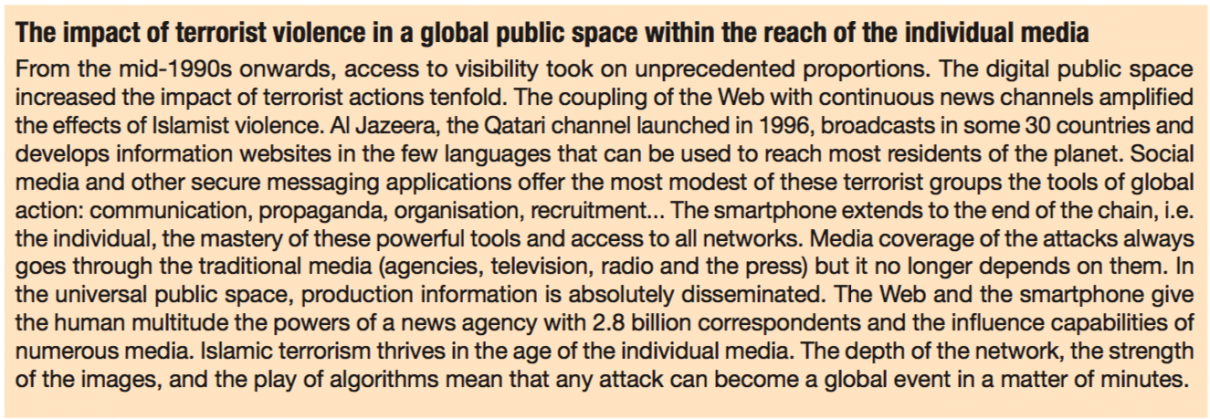
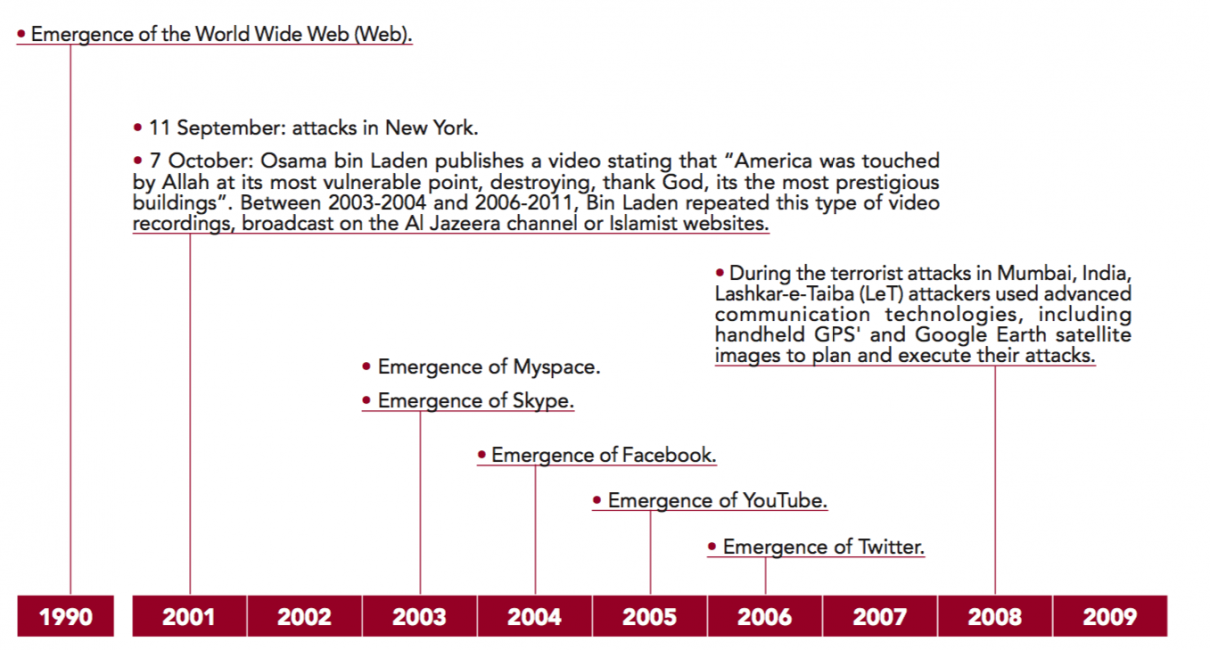
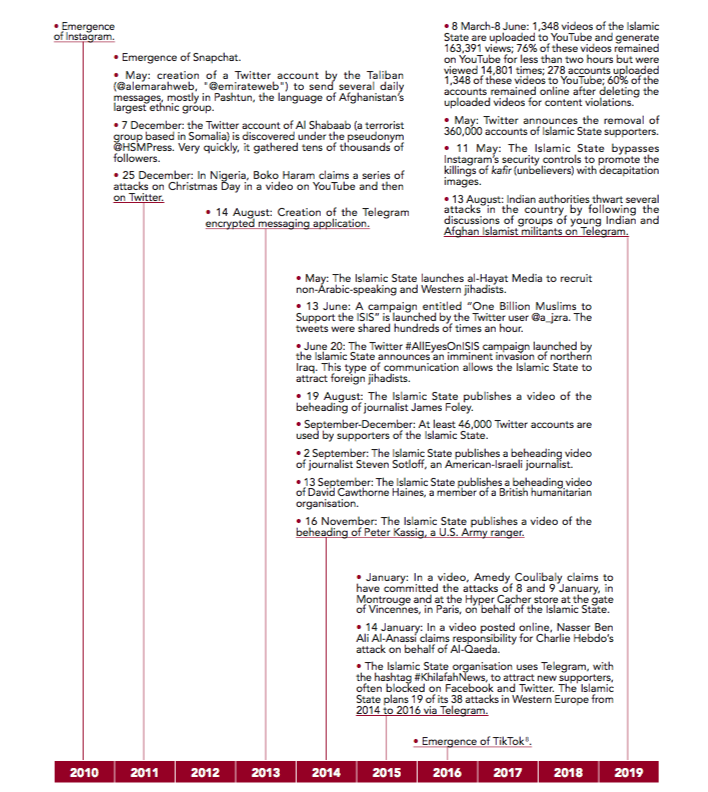
The irruption of the Islamic State and Boko Haram (2013-2019)
Translated from Hakim El Karoui, La Fabrique de l’islamisme, Institut Montaigne, September 2018, 85 (Full report in French ; Shortened version in English).
On 17 December 2010, the immolation of the young street vendor Mohamed Bouazizi, in the Sidi Bouzid region of Tunisia, led to the flare-up of the Arab Spring. After some time raising hopes of democratisation, these events led, in the first half of the 2010’s, to electoral victories for parties close to the Muslim Brotherhood. While they occasionally failed to retain power, they are “supported by increasingly conservative societies, also as a result of the spread of Salafism imported from Saudi Arabia”1.
In this new context, jihadism is developing regionally, based in particular on the proclamation by the Islamic State (IS) of the Caliphate in Mosul in 2014. It is during this period that Islamist terrorism is the most deadly. There has been an unprecedented increase of the number of attacks worldwide. The rise of IS and Boko Haram is facilitated by chaotic geopolitical contexts that offer terrorists many opportunities for expansion.
The Islamic State and the “management of savagery”
Expression taken from “The management of savagery: the most critical stage that the ummah will go through”, a text published in Arabic on the Internet in 2004 and written under the name of Abu Bakr Naji, pseudonym of Mohamed Hassan Khalil al-Hakim, aka Abu Jihad al-Masri, an Al-Qaeda executive. This text is intended to serve as a spiritual guide for many He explained the strategy to be put in place to establish an Islamic caliphate. According to some commentators, the manifesto counts “103 pages of hate speech, against the Jew, against the Christian, against the apostate, against democracy and its values. So much so that some have described it as the little jihadist’s Mein Kampf. The interest of this book is that it puts us, from the title, in front of the paradox of jihadism, which on the one hand advocates the unleashing of savagery, the installation of the law of the jungle, with the call for the destruction of the ancient order, and at the same time theorises the management of this savagery and its “administration” (Translated from Abderrazak Sayadi and Alberto Fabio Ambrosio, “Terrorisme: Anatomie du ‘Mein Kampf’ djihadiste“, counterpoints.org, 27 March 2018.
The group Islamic State emerged and then settled during the Iraqi civil war, between 2003 and 2011. The organisation was created in 2006 and, three times, its name change accompanied its expansion outside its Iraqi hub: first as an Islamic State in Iraq (ISI, 2006- 2013), then as an Islamic State in Iraq and the Levant (ISIL, 2013-2014) and finally as an Islamic State (IS, from 2014).
Theorised in the 2000s, the strategy of the IS is to promote chaos, the “management of savagery”2, and to globalise jihad. Its objective is to cultivate religion in the minds of the masses, to make Islam the only political and social order, and to train young people in order to establish a militarised society.

See Mathieu Guidère, Atlas du terrorisme islamiste. D’Al-Qaida à Daech, Autrement, 2017.
For example, the attempted attacks in Villejuif on 19 April 2015 and on the Thalys train on 21 August 2015.
See Anne-Aël Durand, William Audureau, Maxime Vaudano, Madjid Zerrouky and Gary Dagorn, “Les attaques de l’État islamique ont fait plus de 2 500 morts en deux ans”, fr, 17 June 2016.
IS operates in several ways. The terrorist group may incite individuals to act alone. These are the “lone wolves”. Popularised in the 1990s, this expression has been used by the IS through different publications. A lone wolf becomes radicalised, plans and executes an attack on their own, without being affiliated with a particular terrorist group, even if they can claim the attack on behalf of the IS3. It should be noted that failed attacks are generally not claimed by the Islamic State4. The Iraqi-Syrian “parent company” directly claims responsibility for the most deadly attacks5. For example, the attack the Bardo Museum, Tunisia, on 18 March 2015, or the attacks of 13 November 2015 in France, were claimed the next day by the IS. As it gains momentum, the IS extends its battlefield. According to our database, it is from 2013 onwards that the organisation has multiplied the number of its terrorist attacks. For that year, we count nearly thirty-one times more attacks by the IS compared to the previous year (374 attacks in 2013, 12 in 2012).
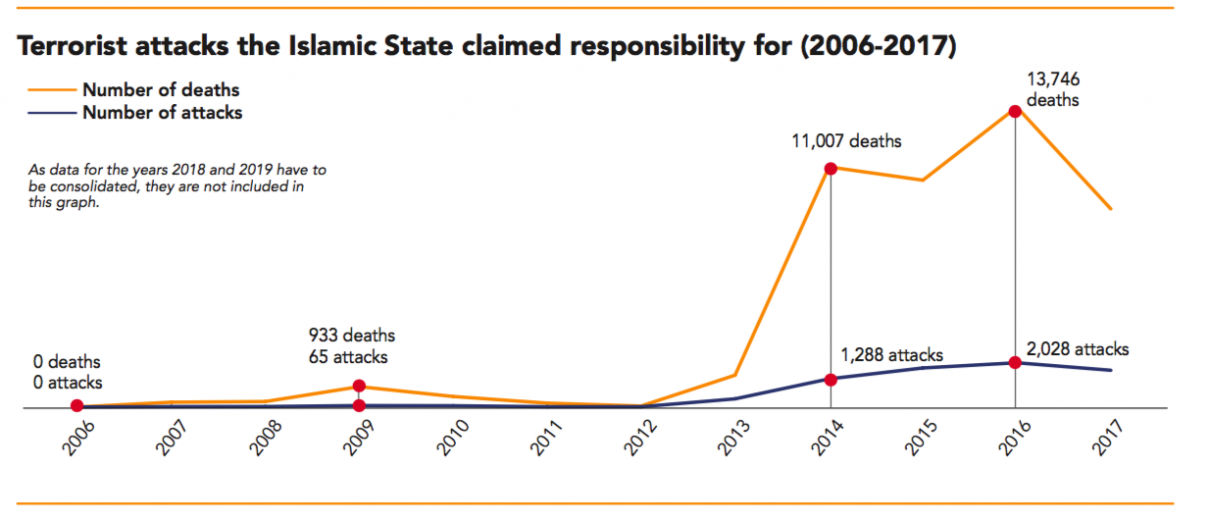

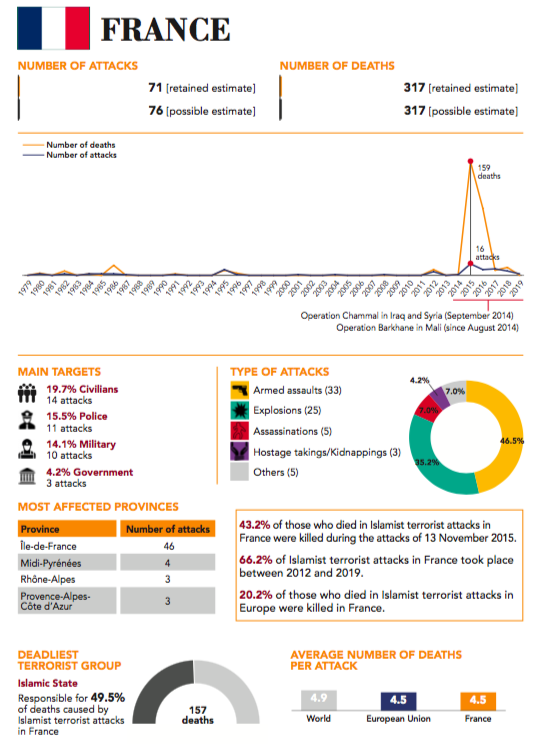
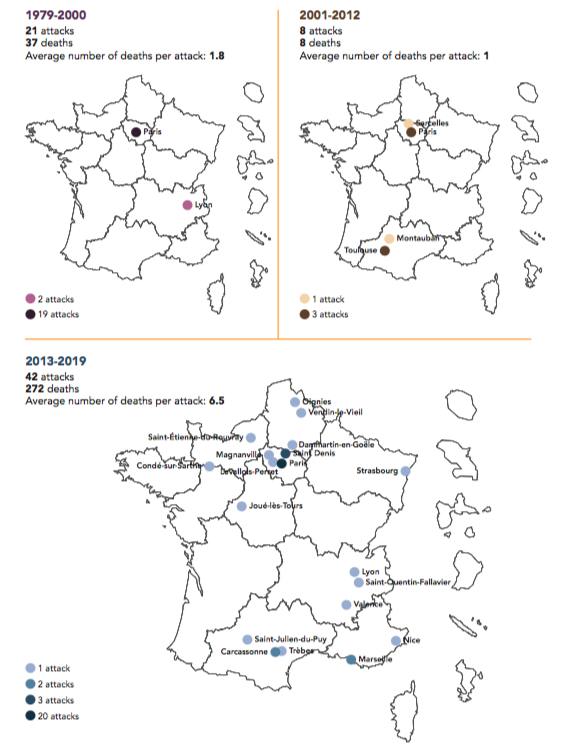
It should be noted that Boko Haram is not included here, although this group pledged allegiance to the IS in March 2015. We dedicated the following section to this terrorist group in order to highlight its uniqueness. Nevertheless, by adding the terrorist acts of Boko Haram committed since March 2015 to the number of attacks perpetrated by the IS and its various branches since its creation in 2006, we obtain the figure of 10,833 attacks that caused the deaths of 74,895 people.
Following the proclamation of the “Caliphate” in June 2014, a multitude of small Islamist groups joined the IS banner. This expansion strategy allows the organisation to establish itself throughout Africa and the Middle East by drawing on the support of local jihadist groups. In 2016, the IS murdered 13,746 people. This was the deadliest year recorded over the entire 1979-2019 period. The number of the IS’ victims has increased ninefold in three years (1,458 deaths in 2013, 13,746 deaths in 2016). The graph on page 31 shows the evolution of the number of attacks committed by the various branches of the Islamic State since its inception to 2017.
The territories most affected are the places where the IS has been historically established, namely Iraq and Syria. The wars that affect these states have facilitated its development by allowing it to conquer several cities and provinces, and to establish a totalitarian order driven by the objective of restoring an “Abbasid caliphate”. IS terrorists are most destructive in Iraq, where they carried out 5,350 attacks, killing 34,158 people. This means that of the 41,544 people killed in Iraq as a result of Islamist terrorism since 1979, 82.2% were victims of the Islamic State between 2006 and 2019.
In Syria, Islamic State attacks have been very deadly, with 746 attacks costing the lives of 8,923 people; on average, in the country, the IS causes the death of 12 people each time it attacks. Some neighbouring countries are affected by the intrusion of the IS, through its ramifications, particularly from 2014 onwards. Here again, these interferences are facilitated by destabilisation contexts which, in turn, favour the influence of the terrorist organisation on these territories which the IS considers its “new provinces”: Libya (550 attacks, 1,172 deaths), Egypt (498 attacks, 1,888 deaths), Yemen (103 attacks, 947 deaths), but also Afghanistan (351 attacks, 2,695 deaths) and Pakistan (118 attacks, 743 deaths).
With the exception of South America, countries on other continents are targeted by the IS in attacks on their territory as well as against their nationals abroad. Several European Union countries are severely affected, and France, with 19 attacks and 157 deaths caused by the IS, is the most bruised European Union country.
The Lake Chad region against Boko Haram’s mass terrorism
In the Hausa language, boko haram can be trans- lated as “Western education is a sin”. The Boko Haram movement was founded by Nigerian preacher Mohamed Yusuf in 2002 in Maiduguri, capital of Borno State, Nigeria. From an Islamist sect to an armed struggle movement in 2009, the organisation advocates a Jihadist Salafist Islam hostile to any Western influence. Its objective is to create a caliphate, governed by Sharia law, just like the IS, to which it pledged allegiance in March 2015 by being referred to as the Islamic State in West Africa.
The group amplified its terrorist activism from 2009 onwards, leading an insurgency for the creation of a caliphate in Nigeria. In 2013, Nigerian President Goodluck Jonathan declared a state of emergency and the Nigerian army launched an offensive throughout the country. Despite this, Boko Haram is taking control of new areas, including Borno State, where 65% of its attacks are concentrated (1,461 of the 2,248 Boko Haram attacks in Nigeria). As of 2014, the Islamist group’s theatre of operation extends to the countries bordering Lake Chad, in northern Cameroon, in Niger and in Chad.
Between 2009 and 2019, Boko Haram was res- ponsible for 2,649 attacks. The human toll (22,287 deaths) is particularly cruel. A significant number of refugees have fled their cities or even their countries. Women and children have even been kidnapped to serve the terrorist organisation, as was the case in April 2014 when 276 high school girls where kid- napped in Chibok, Nigeria.
On 23 March 2019, thanks to Arab-Kurdish forces supported by the United States, the IS was defeated. The end of the self-proclaimed caliphate is official with the taking of the last Syrian territory held by the jihadist organisation. However, deprived of its Iraqi-Syrian stronghold, the IS does not lose all its capacity to cause disturbance and decentralise its activism to its subsidiaries. From the data we have collected, we record 834 attacks (4,811 deaths) by the IS between 2018 and the end of August 2019 (1,062 attacks and 6,690 deaths including Boko Haram). This list may be incomplete, but these figures nevertheless illustrate the persistence of the terrorist action of the IS, as reflected by the deadly attacks of 21 April 2019 in Sri Lanka on Easter Sunday, as well as, on the same day, the attacks against three police officers in Saudi Arabia.
The suicide attack, the “martyr” and the terror
See Alain Louyot, “Les ‘petits martyrs’ de la guerre Iran-Irak“, lexpress.fr, 27 September 2001.
It was first during the Iran-Iraq conflict (1980-1988) that we began talking about “suicide attacks”. It was then a question of tactical warfare. On 30 October 1980, Mohammad Hossein Fahmideh, a 13-year-old fanatical Shiite, committed suicide by throwing him- self, grenade in hand, under a tank. In total, there were several thousand Iranian children under the age of 16-years-old who would rush onto minefields in order to trigger the explosions and allow troops to pass in order to fight on behalf of the Islamic Republic of Khomeyni6. It was then in the context of the Lebanon War that the first “suicide attacks” were perpetrated. In Beirut, on 23 October 1983, two suicide attacks orchestrated by Hezbollah target the American and French contingents of the Multinational Force of security. The first led to the deaths of 241 American soldiers, the second of 58 people, including French paratroopers and the Lebanese family of a building caretaker.
A total of 19 suicide attacks will be committed between 1979 and 2000. They represent 0.9% of the 2,190 acts of Islamist violence in the world.
Suicide attacks require few resources, produce considerable damage and are susceptible to have maximum media impact. Indeed, it profoundly modifies the narrative of the act. It is no longer an attack perpetrated by a terrorist who does not expose them- self or their life to any risk; they are a “martyr” who accept and lead their own “sacrifice” for a cause. Its impact is further increased by the use of the new media order that allows the “martyr” to display their death by filming himself using their smartphone connected to the Web.
See Daniel Pipes, “The [Suicide] Jihad Menace”, The Jerusalem Post, 27 July 2001.
See Robert Pape, “The Strategic Logic of Suicide Terrorism”, The American Political Science Review, vol. 97, nº3, August 2003, p. 343-361, or Scott Atran, “The Moral Logic and Growth of Suicide Terrorism”, The Washington Quarterly, vol. 29, nº 2, Spring 2006, p. 127-147.
See Ehud Sprinzak, “Rational Fanatics”, Foreign Policy, nº 120, September-October 2000, 66-73.
Between 2001 and 2012, the use of suicide attacks increased significantly (679), to then represent 8.2% of all Islamic attacks (8,264). The story of the jihadist martyr is carefully crafted and maintained by radical Islamists; their efforts are focused on the religious valorisation of the terrorist gesture. The “terrorist” must consider himself as a shahid (martyr). Thus, for these men and women who, in most cases, are under 30 years-old, the act to kill by taking your own life is no longer perceived as a suicide – considered a sin – but it is supposed, on the contrary, to bear witness to great piety to the extent that it harms non-Muslims7.
If, in Western public opinion, the author of a suicide attack is more often associated with the idea of a fanatical, of a miserable or psychologically unbalanced person, a number of studies seem to contrast this portrait by highlighting the relatively high socio-cultural level of a majority of terrorists killed in suicide attacks8. This is the case, for example, within Hamas and the Palestinian Islamic Jihad Movement, whose terrorists that resort to suicide bombing are generally identified as university graduates and middle-class people9.
Over the period 2013-2019, 1,820 attacks have been identified as suicides, representing 7.8% of the 23,315 Islamist terrorist attacks. Among the attacks carried out by the Islamic State and by Boko Haram, the suicide attack is frequently used. It reflects the culture of death maintained and developed among young jihadists. For Boko Haram, we have identified 437 suicide attacks since 2009, representing 16.5% of the total number of all attacks attributable to this group, while they represent 10.4% (847) of the total attacks by the IS. To carry out its suicide attacks, Boko Haram indoctrinates, manipulates, recruits or coerces women, teenagers and very young children in particular.

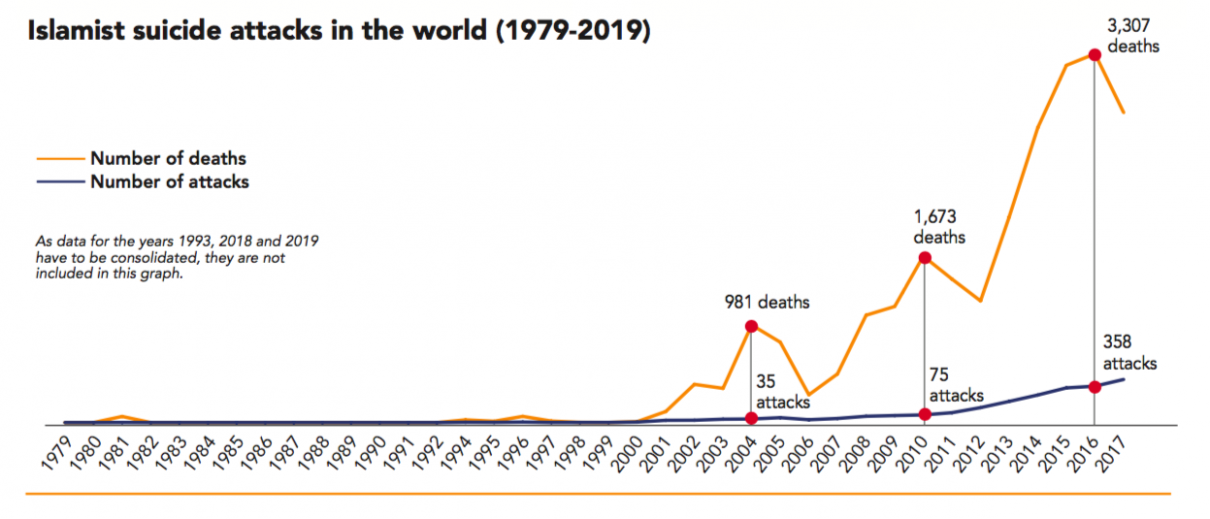

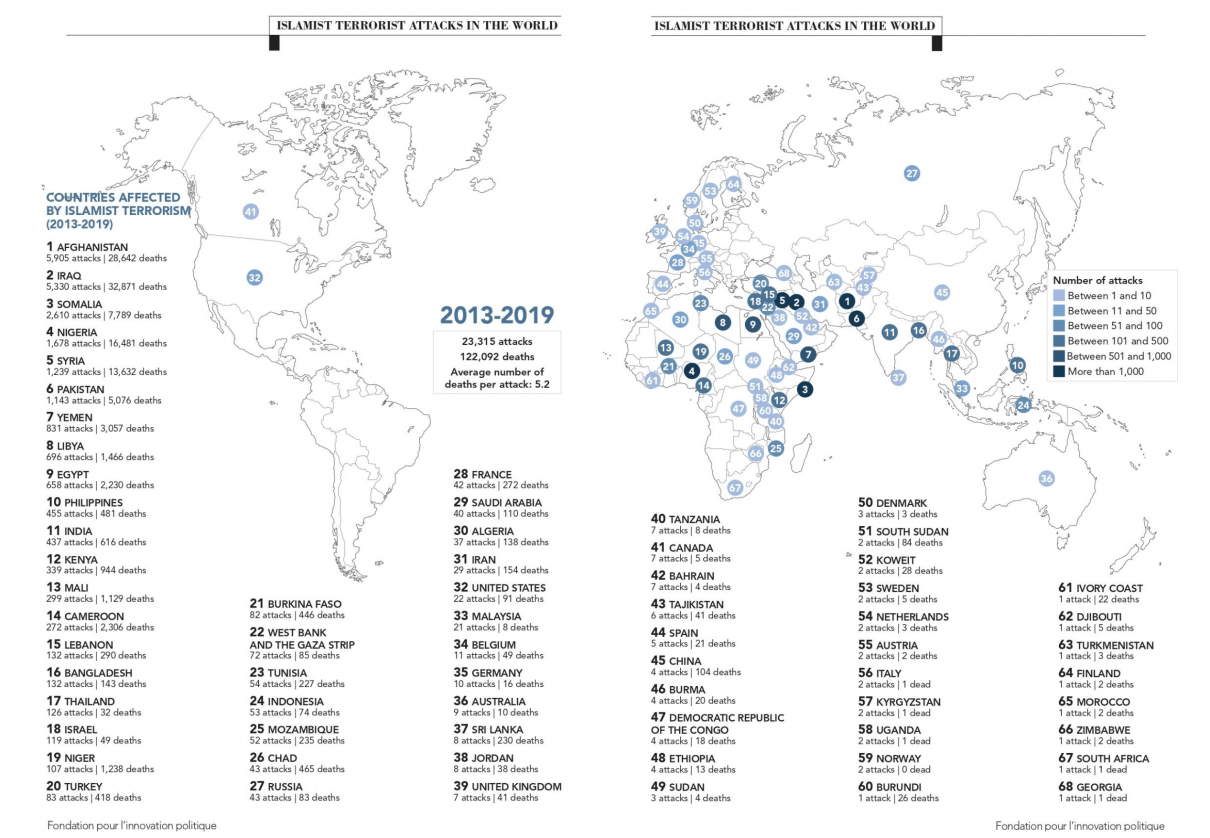
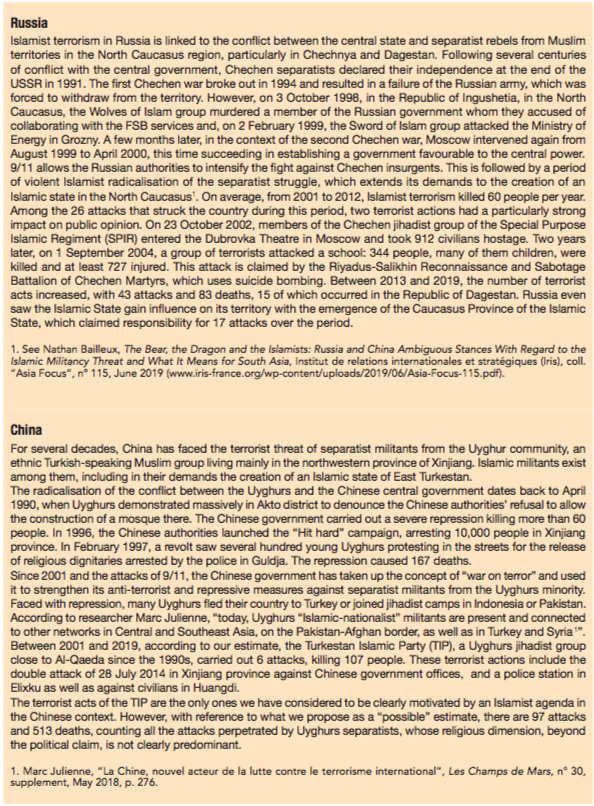
Additional data: the estimation of attacks in 2018 and 2019 by an extrapolation of trends
For 2018 and for the period January-August 2019, the identification of Islamist terrorist attacks in the world is still to be specified, completed and consolidated. We sought to provide information for the year 2018 and the months of January to August 2019. For 2018, we have 1,606 attacks and 8,715 deaths.
In 2019, there were 826 attacks and 4,953 deaths. However, we believe that these figures substantially underestimate the reality. At this stage of our work, to better approach this reality, which evades us in part, we propose the use of a simple method of extrapolation based on the aggregation of our data to the extent that the importance of the volume gives them a value of meaning.
First extrapolation. From the consolidated database for the period 2013-2017, we calculate two annual averages, that of the number of Islamist terrorist attacks (4,177) and the number of deaths (21,685) due to Islamist terrorist attacks, which we then allo- cate to the years 2018 and 2019.
However, our data concern political realities that are highly dependent on a historical context, which is by definition subject to change, sometimes suddenly. This is what the rapid growth of the Islamic State star- ting from 2013 and the intensification of its terrorist activism until its alleged fall, in 2017, shows us. Our first extrapolation being based on this time frame, it calls for at least another one. We will assume a “post-IS” era here of Islamist violence.
Second extrapolation. From our data for the period 2001-2017, we calculate two annual averages, that of the number of attacks Islamists (1,715) and the number of deaths (8,624) due to Islamist terrorist attacks, which we then allocated to the years 2018 and 2019.
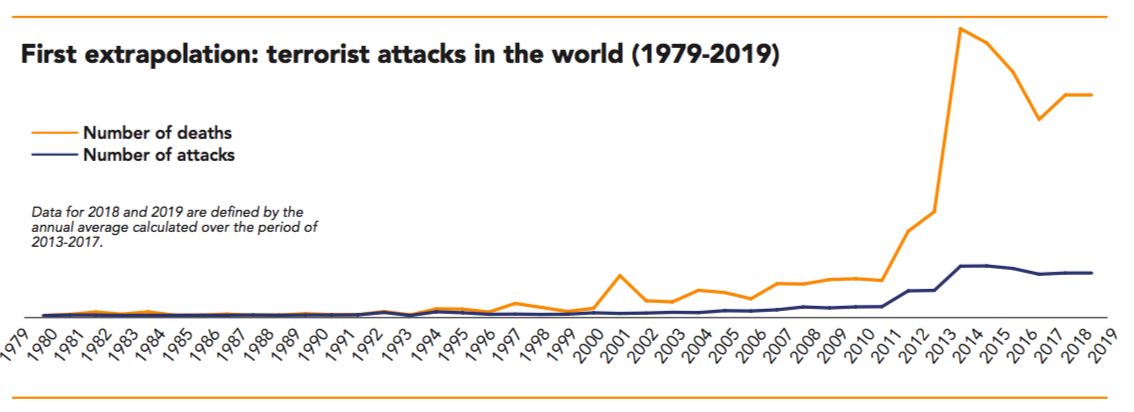
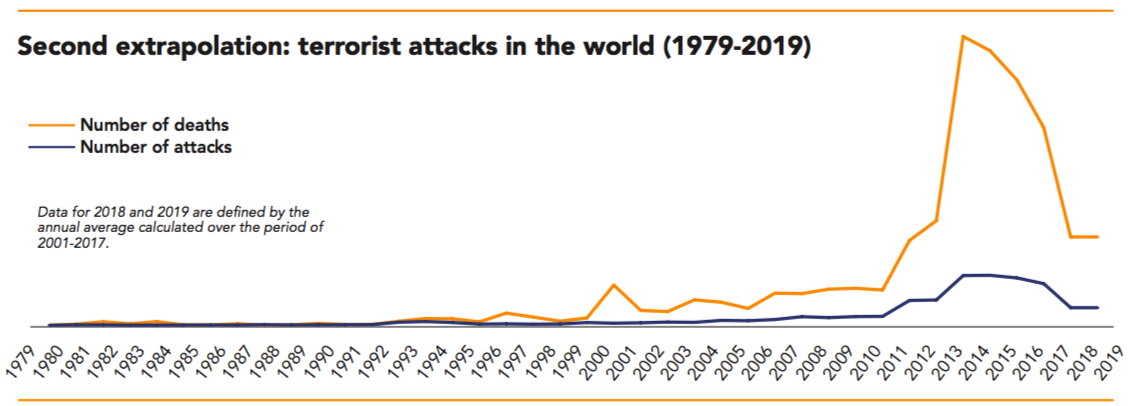
The territories of Islamist terrorism (1979-2019)
The globalisation of Islamist terrorism can refer to the global visibility that digital technology provides to their attacks, but it can also designate a geographical reality: more or less, all the regions of the world have been hit. Of course, the damage caused vary considerably depending on the parts of the world. On the number of attacks since 1979, almost all of them (94.7%, or 31,963 attacks) took place in the countries of the Middle East and North Africa, South Asia and Sub-Saharan Africa. With regard to the 167,096 deaths, a considerable proportion (95.6% or 159,723 deaths) was also recorded in these three regions. Undeniably, the Western world is less affected. However, Europe and the United States have faced an increasing and changing threat, with particulary murderous attacks, such as in the United States in 2001, in Spain in 2004, in the United Kingdom in 2005, in France in 2015 and 2016. A multifold of tragedies that remain present in our collective memories.
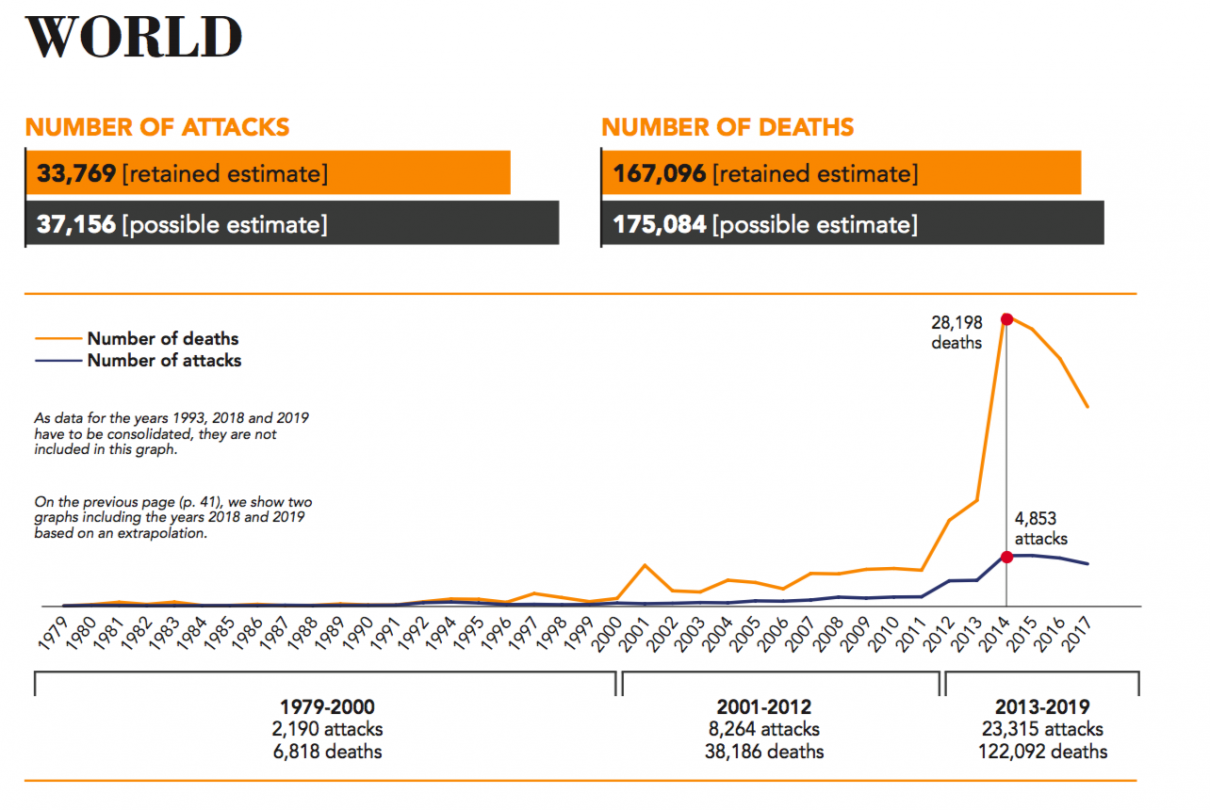
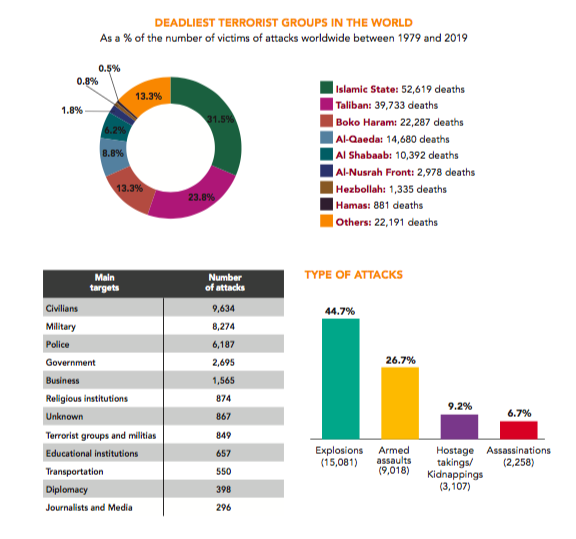

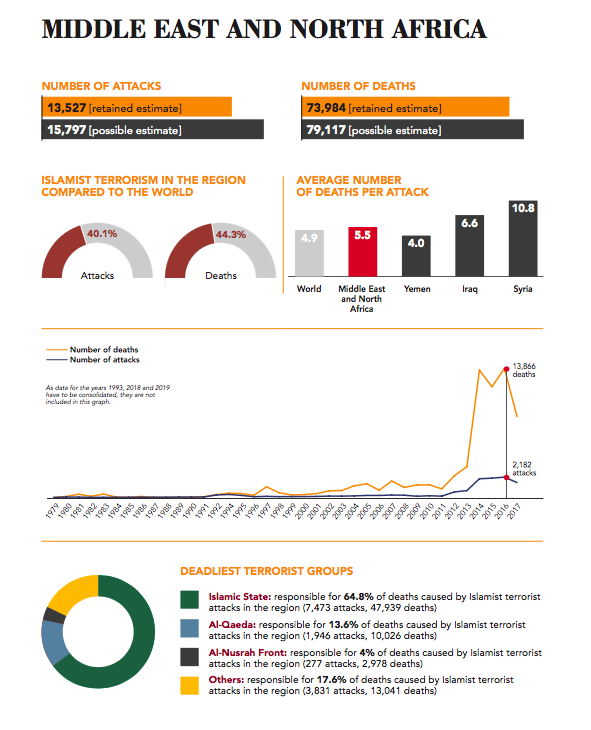
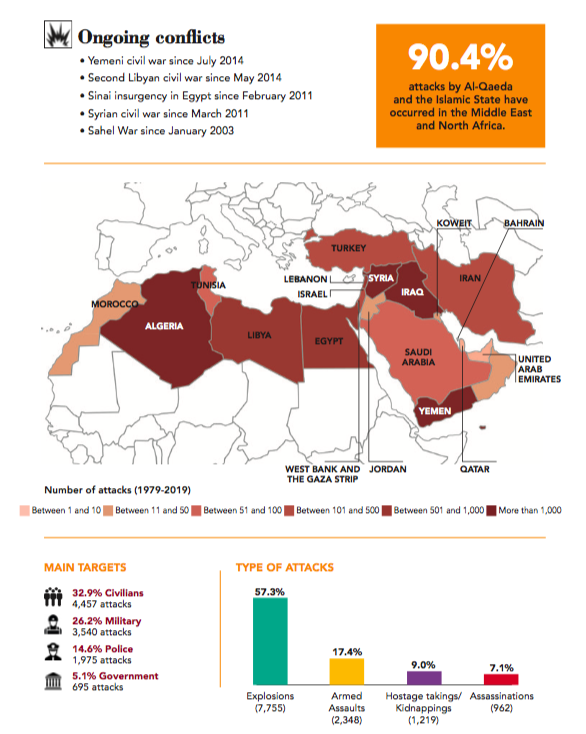
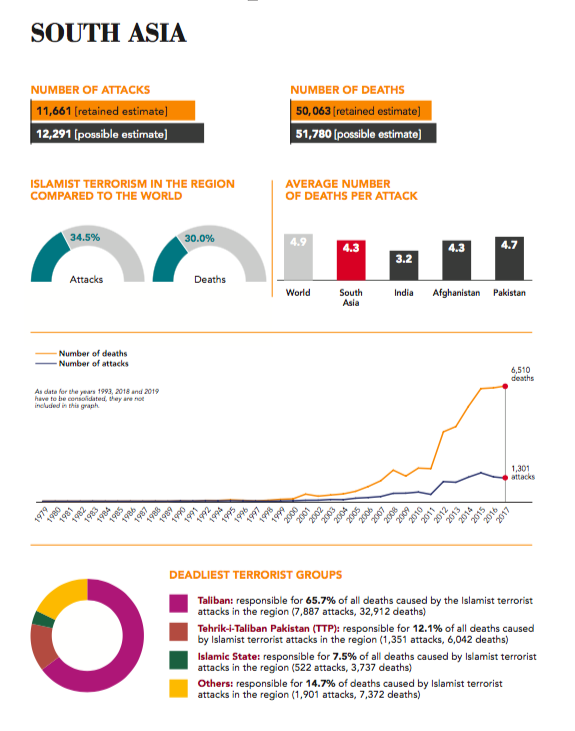
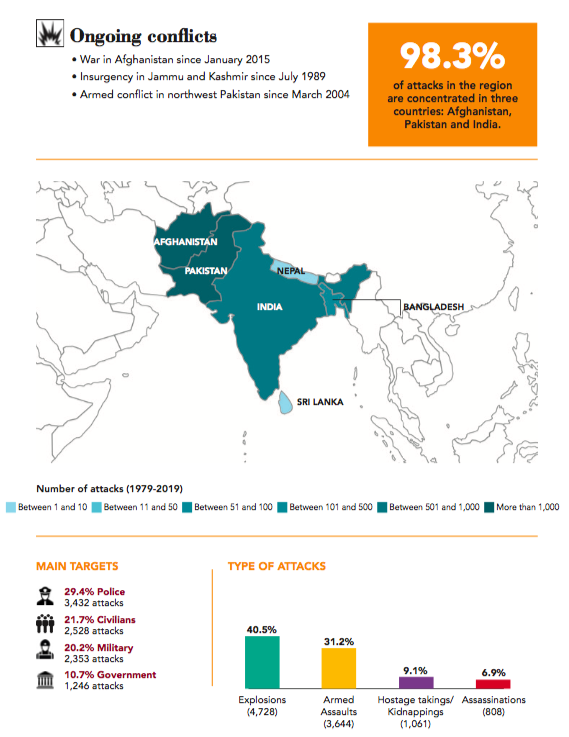
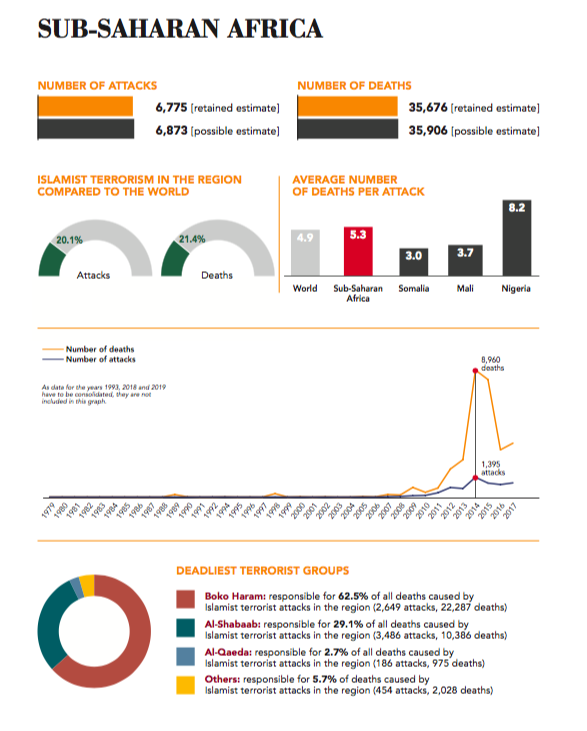
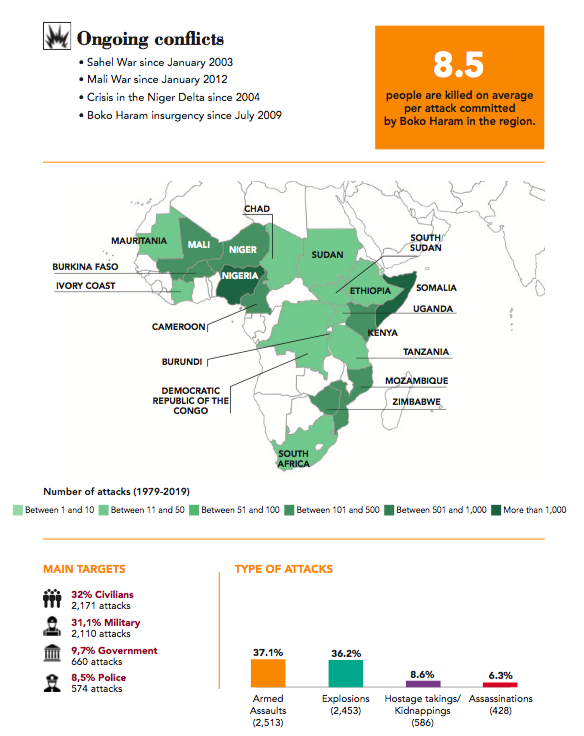
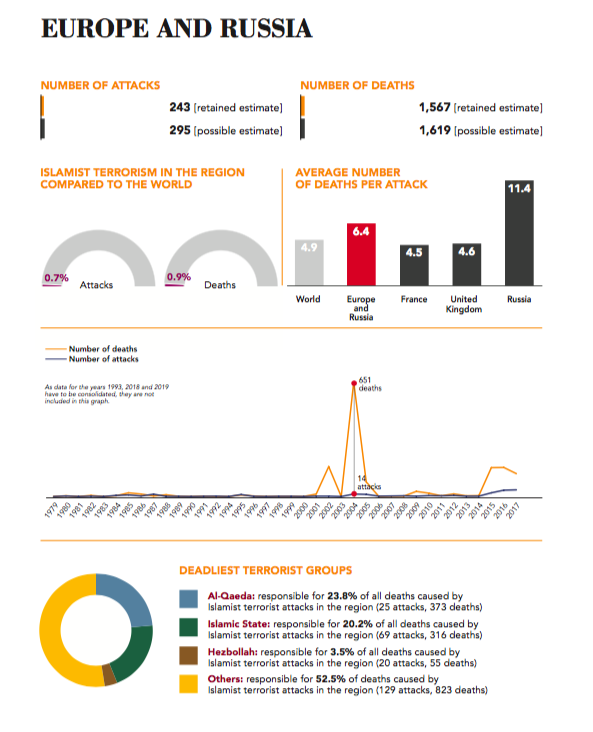
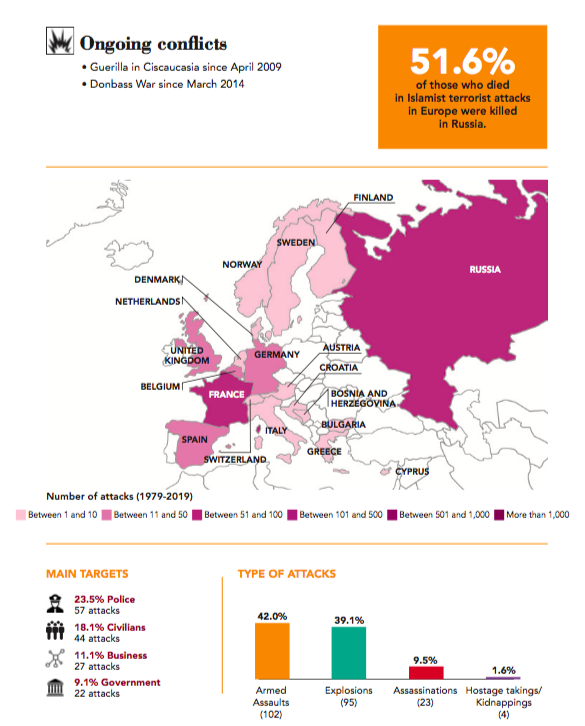
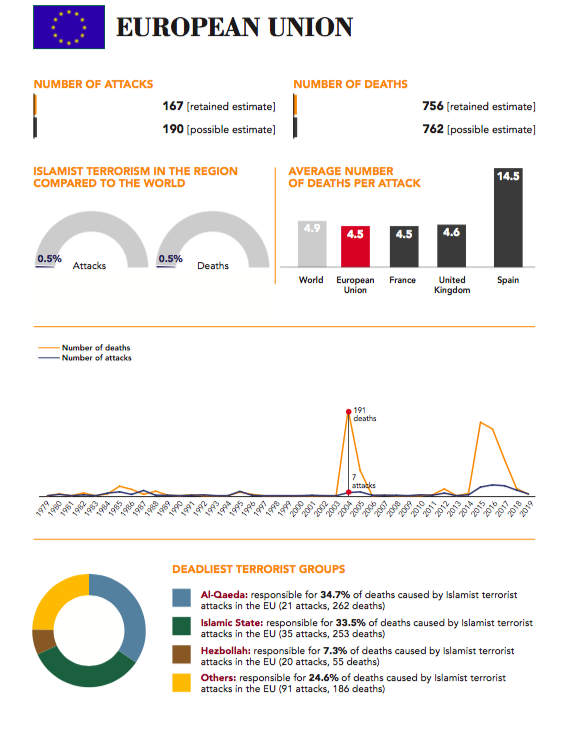
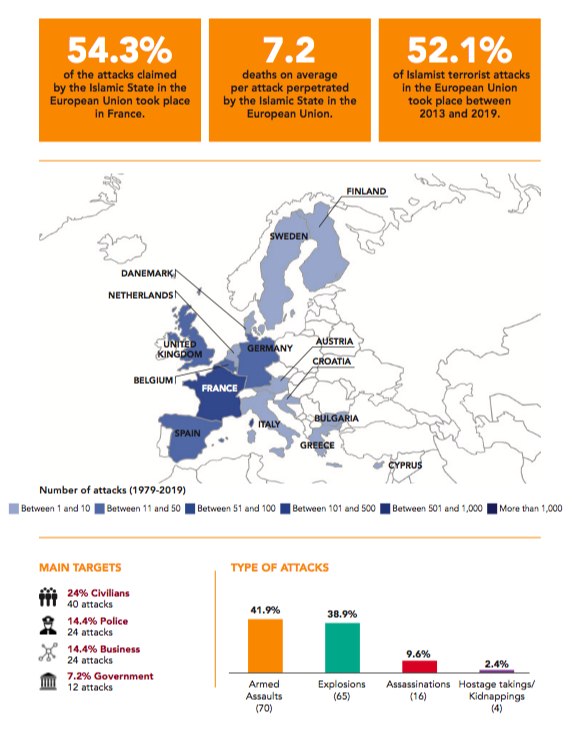
The most affected countries (1979-2019)
Over the period studied, 81 countries were affected by at least one Islamist attack. Among these countries, 19 are European countries (20 including Russia), 15 of which are members of the European Union. Overall, 23 countries have a democratic system. It is also observed that countries most affected by Islamist terrorist attacks in the last forty years are those who have experienced periods of war: Afghanistan, Iraq, Lebanon, Libya, Turkey, Somalia, Syria… Most of the 81 countries affected by Islamist violence are developing countries.
Finally, it should be noted that the vast majority (89.2%) of Islamist terrorist attacks have been committed in Muslim countries. As a result, most of them deaths caused by Islamist terrorist attacks (91.2%) are also recorded in Muslim countries. These figures underestimate the reality since they do not take into account the attacks Islamists perpetrated in countries with a majority of non-Muslim where Muslim populations are concentrated in certain provinces. Most of the lives lost are therefore Muslim lives.
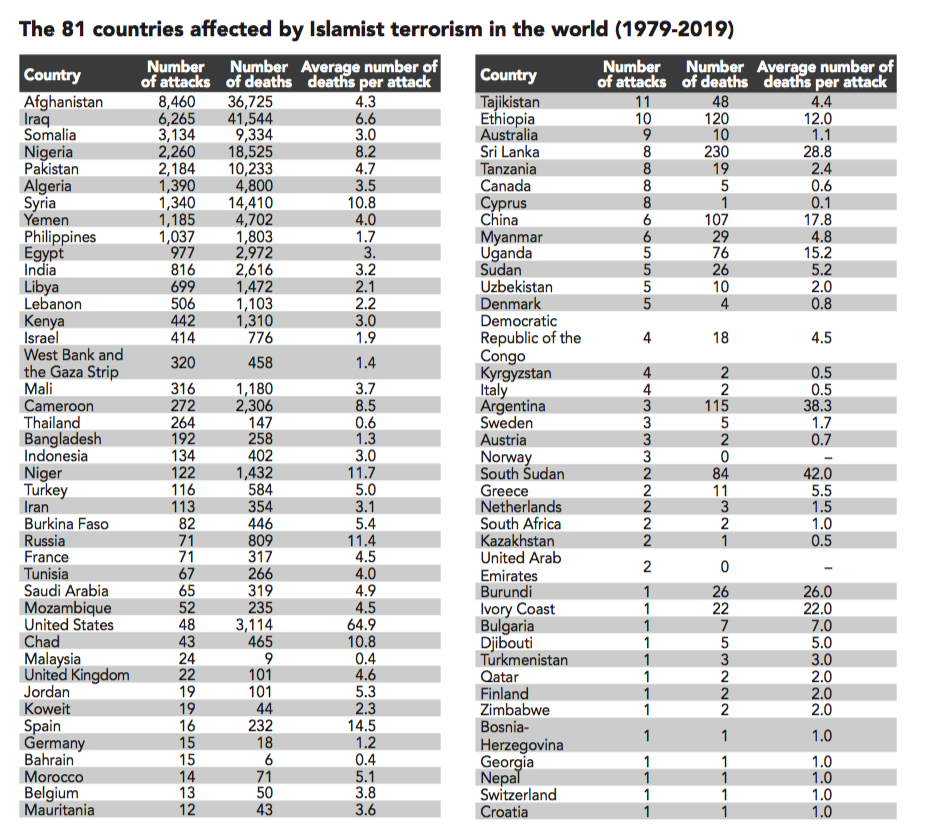
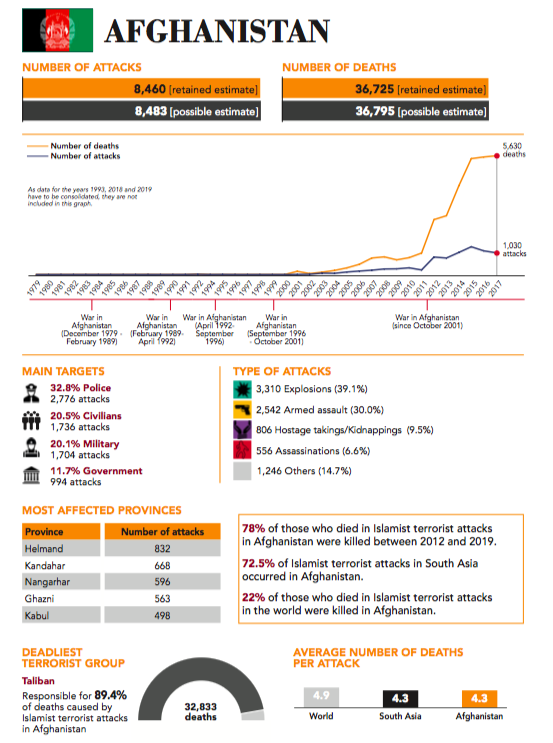
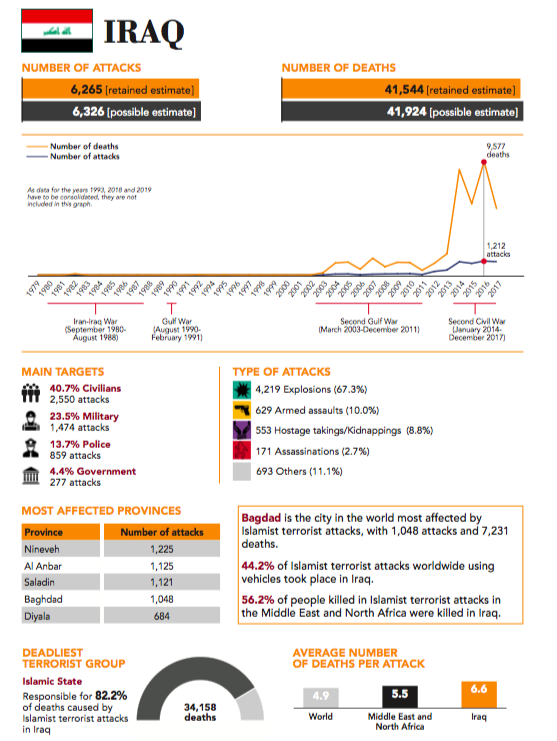
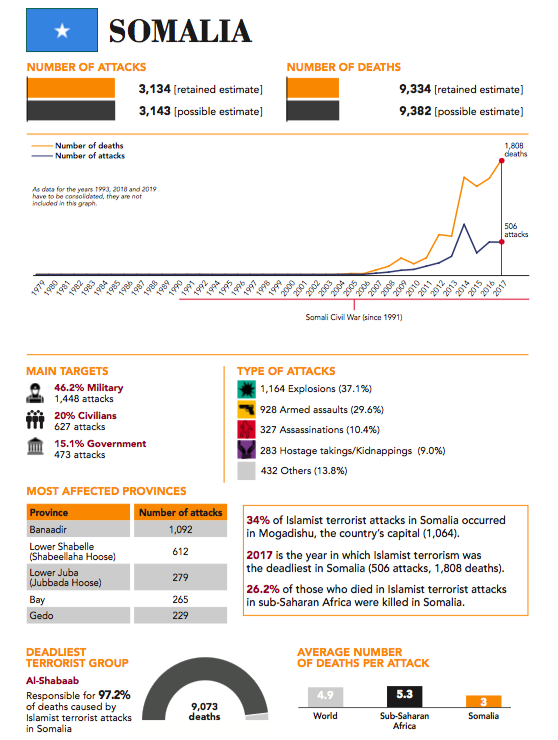
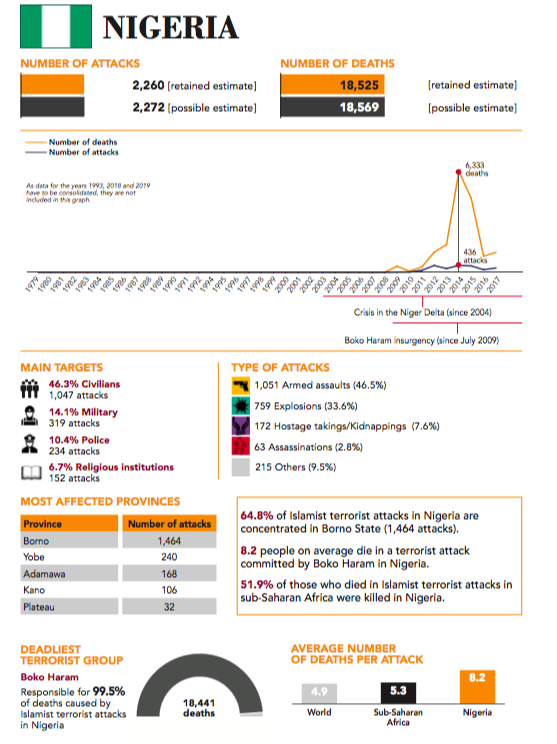
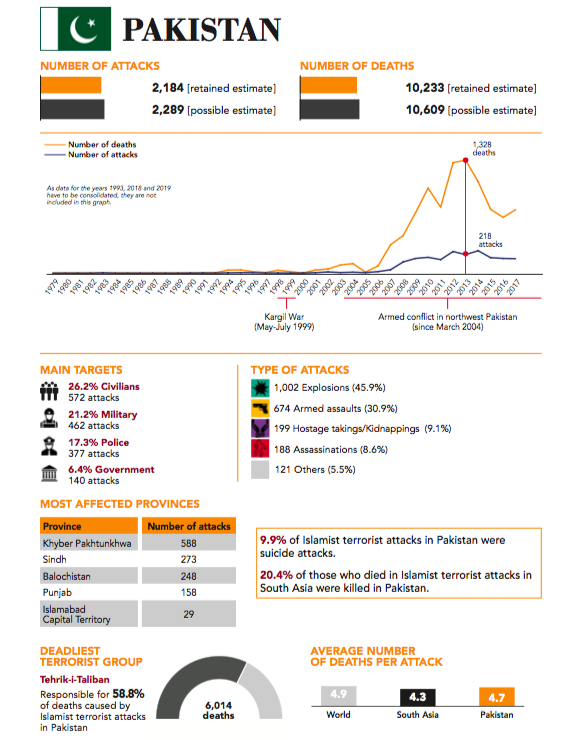
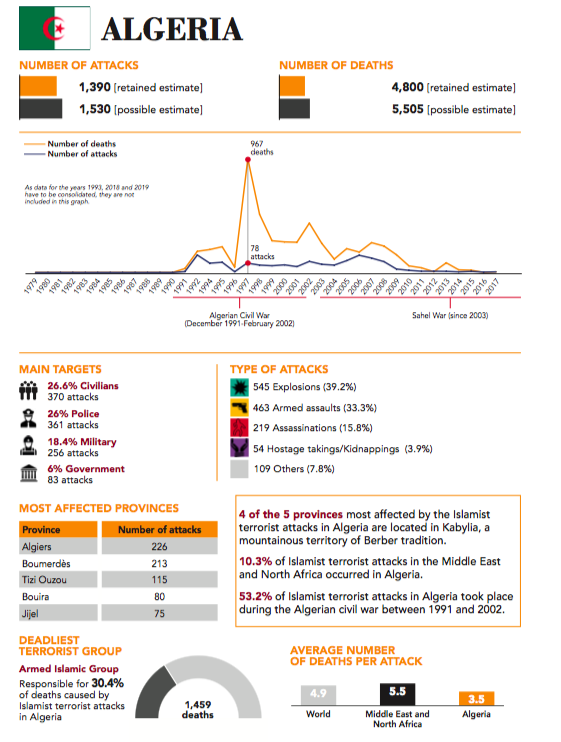
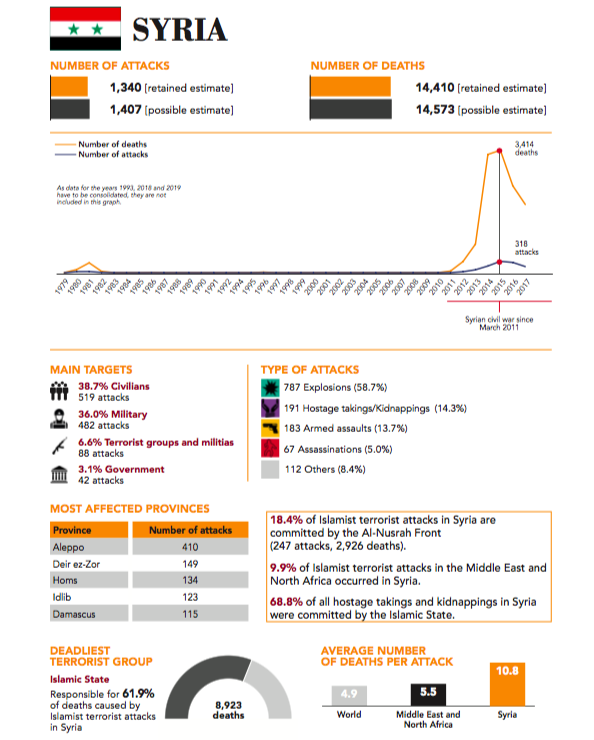
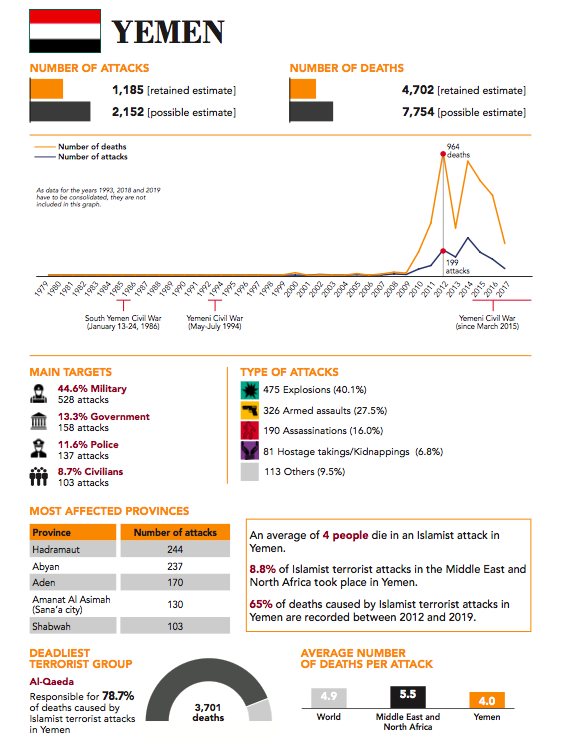
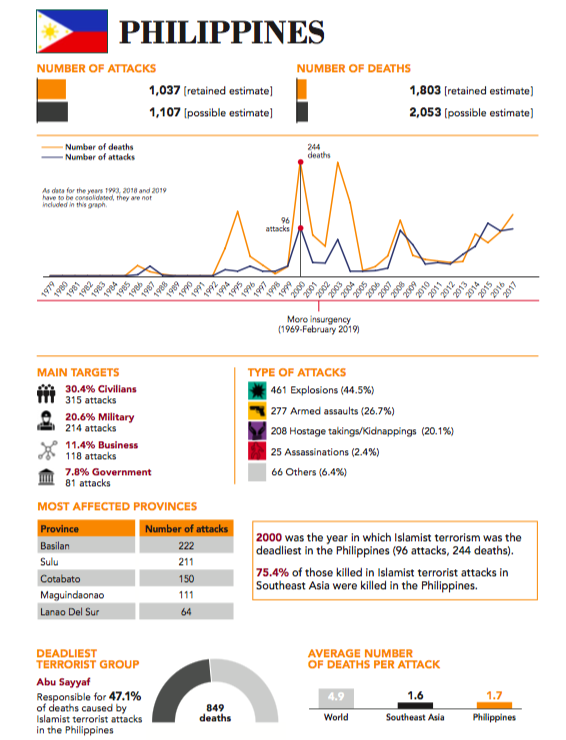
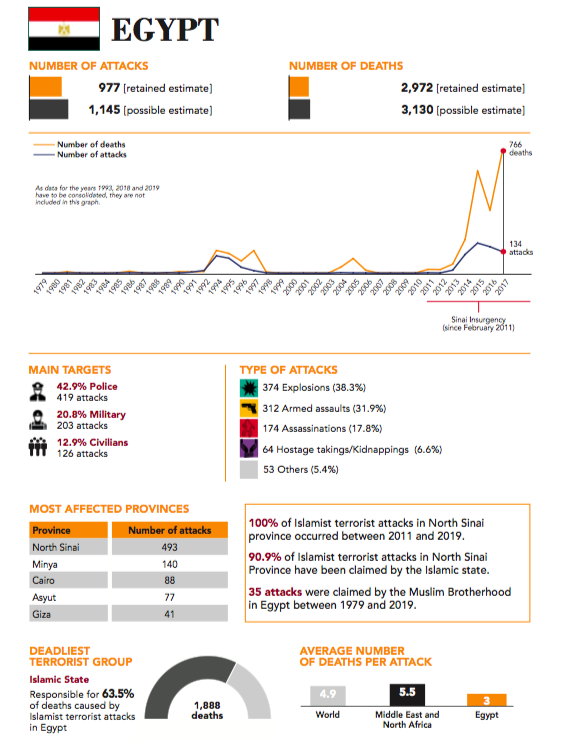
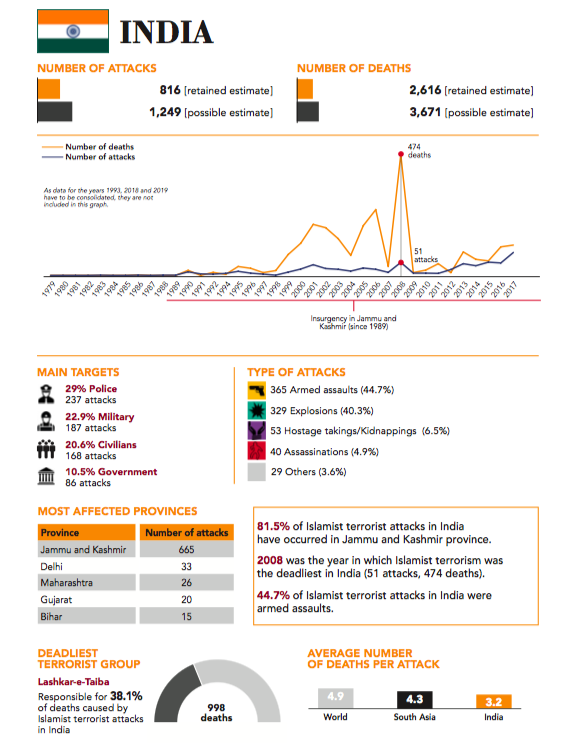
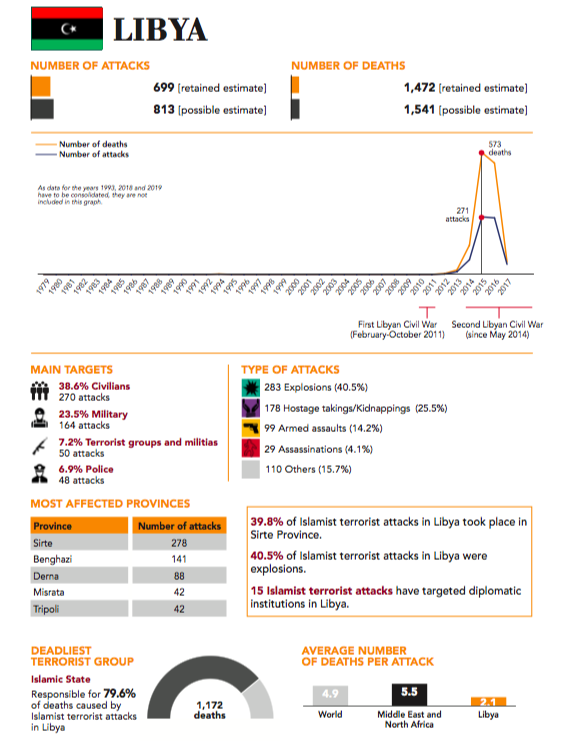
In conclusion, the main lessons of our study
1. Between 1979 and 2019, we counted 33,769 Islamist terrorist attacks around the world, which have resulted in the deaths of at least 167,096 people.
- 1979-2000: 2,190 attacks and 6,818
- 2001-2012: 8,264 attacks and 38,186
- 2013-2019: 23,315 attacks and 122,092
For 2018 and for the period January-August 2019, the database is still to be specified and completed. In 2018, we recorded 1,606 attacks and 8,715 deaths; in 2019, 826 attacks and 4,953 deaths. In the introduction we give some of the reasons why these figures underestimate the reality. With an extrapolation exercise, which is precisely allowed by the volume of data collected, we can provide information for the years 2018 and 2019 with the annual mean 2001-2017 of the number of attacks (1,715) and the number of deaths (8,624). We hereby obtain 34,766 Islamist terrorist attacks worldwide between 1979 and 2019 and 170,676 deaths.
2. Islamist terrorist attacks accounted for 8% of all attacks worldwide between 1979 and 2019.
- 1979-2000: 3.5% (2,190 Islamist terrorist attacks out of 61,746 attacks).
- 2001-2012: 19.8% (8,264 Islamist terrorist attacks out of 41,650 attacks).
- 2013-2019: 9% (24,312 Islamist terrorist attacks out of 81,337 attacks).
For this chronological sequence, concerning the years 2018 and 2019, we used the extrapolation presented above.
3. Between 1979 and 2019, terrorist attacks (Islamist and other) around the world killed at least 436,170 people. Over the same period, Islamist terrorist attacks accounted for 39.1% of all deaths in all attacks. But Islamism has become the major cause of death by terrorism from 2013 onwards.
- 1979-2000: 5% (6,818 deaths out of 137,690).
- 2001-2012: 1% (38,186 deaths out of 100,129).
- 2013 and 2019: 4% (125,672 deaths out of 198,351).
For this chronological sequence, concerning the years 2018 and 2019, we used the extrapolation previously presented.
4. On average, an Islamist attack caused the deaths of 4.9 people. The number of deaths per attack tends to increase.
- 1979-2000: An attack killed an average of 3.1
- 2001-2012: An attack killed an average of 4.6
- 2013-2019: An attack killed 2 people on average.
5. There were 2,518 suicide attacks over the entire period, which represents 7.5% of all Islamist terrorist attacks.
- 1979-2000: 19 suicide attacks (0.9% of attacks).
- 2001-2012: 679 suicide attacks (8.2% of attacks).
- 2013-2019: 1,820 suicide attacks (7.8% of attacks).
Among the main terrorist organisations in the database, the one that has used suicide attacks most often is Boko Haram: 16.5% of its attacks were suicide attacks.
6. Half (51.2%) of Islamist terrorist attacks were caused by explosives. It is the most commonly used type of weapon (17,303 attacks), followed by ftrearms (10,501 attacks), incendiary weapons (810 attacks) and melee weapons, such as knives or machetes (785 attacks).
- 1979-2000: firearms (910), explosives (853), melee weapons (124), incendiary weapons (68).
- 2001-2012: explosives (4,515), firearms (2,572), incendiary weapons (234), melee weapons (198).
- 2013-2019: explosives (11,935), firearms (7,019), melee weapons (463), incendiary weapons (508).
7. The Middle East and North Africa, South Asia and sub-Saharan Africa accounted for 94.7% of Islamist terrorist attacks between 1979 and 2019.
- Middle East and North Africa: 40.1% of attacks, 44.3% of deaths.
- South Asia: 5% of attacks, 30% of deaths.
- Sub-Saharan Africa: 20.1% of attacks, 21.4% of deaths.
- South-East Asia: 3% of attacks, 1.4% of the deaths.
- Europe: 7% of attacks, 0.9% of deaths.
- North America: 2% of attacks, 1.9% of the deaths.
- Oceania: 03% of all attacks, 0.01% of the deaths.
- South America: 01% of attacks, 0.1% of the deaths.
8. Afghanistan was the country most affected by Islamist terrorism, ahead of Iraq and Somalia.
The most affected countries are Afghanistan (8,460 attacks), Iraq (6,265 attacks), Somalia (3,134 attacks), Nigeria (2,260 attacks), Pakistan (2,184 attacks), Algeria (1,390 attacks), Syria (1,340 attacks), Yemen (1,185 attacks), the Philippines (1,037 attacks), Egypt (977 attacks), India (816 attacks) and Libya (699 attacks).
In these twelve countries, 149,136 deaths were recorded as a result of Islamist terrorist attacks, representing 89.3% of the total number of deaths recorded worldwide.
9. France was the most affected country in the entire European Union, with 71 Islamist terrorist attacks on its territory between 1979 and 2019. At least 317 people were killed in these attacks.
- 1979-2000: 21 attacks, 37
- 2001-2012: 8 attacks, 8
- 2013-2019: 42 attacks, 272 deaths (given the ongoing investigation, we have chosen not to take into account the attack that took place on 3 October 2019 at the Paris Police Headquarters).
10. The indirect clashes in Afghanistan between the American and Soviet powers are one of the major causes of Islamist violence of the 21st century.
The United States and Russia have also been hit by jihadist terrorism. During the period 1979-2019, we recorded 48 attacks and 3,114 deaths in the United States and 71 attacks in Russia, responsible for the deaths of 809 people.
11. Civilians are the main target (28.5%) of Islamist terrorists, ahead of the military (24.5%) and police forces (18.3%).
- 1979-2000: civilians (424 attacks, 19.4%), military (343 attacks, 15.7%), police forces (407 attacks, 18.6%).
- 2001-2012: civilians (2,168 attacks, 2%), military (1,411 attacks, 17.1%), police forces (1,427 attacks, 17.3%).
- 2013-2019: civilians (7,042 attacks, 2%), military (6,520 attacks, 28%), police forces (4,353 attacks, 18.7%).
12. Most (89.1%) of Islamist terrorist attacks were committed in Muslim countries*. Similarly, the vast majority of deaths caused by Islamist terrorist attacks (91.2%) were recorded in Muslim countries.
- Number of Islamist terrorist attacks in Muslim countries: 30,105 attacks (89.1% of Islamist terrorist attacks worldwide).
- Number of deaths caused by Islamist terrorist attacks in Muslim countries: 152,353 deaths (91.2% of deaths caused by Islamist terrorist attacks worldwide).
It should be noted that these figures underestimate the reality since they do not take into account the Islamist terrorist attacks perpetrated in countries with a non-Muslim majority where Muslim populations are concentrated in certain provinces. This is the case, for example, in southern Thailand, where Muslims are in the majority in Satun, Yala, Pattani and Narathiwat provinces, but also in the Philippines, in the Mindanao region; in India, in Jammu and Kashmir province; or in China, in the Xinjiang Uyghur autonomous region.
*Muslim countries: Afghanistan, Algeria, Bahrain, Bangladesh, Burkina Faso, West Bank and the Gaza Strip1, Chad, Djibouti, Egypt, Indonesia, Iran, Iraq, Jordan, Kazakhstan, Kyrgyzstan, Kuwait, Lebanon, Libya, Malaysia, Mali, Mauritania, Morocco, Niger, Nigeria, Saudi Arabia, Pakistan, Qatar, Somalia, Sudan, Syria, Tajikistan, Tunisia, Turkmenistan, Turkey, United Arab Emirates, Uzbekistan.
13. Over the entire studied period, the deadliest organisation was the Islamic State (IS), including its various branches. Its terrorist actions have caused the deaths of 52,619 people.
The deadliest terrorist organisations, taking into account their different ramifications, were the Islamic State (52,619 deaths), the Taliban (39,733 deaths), Boko Haram (22,287 deaths) and Al-Qaeda (14,680 deaths). These four terrorist groups were responsible for more than three-quarters (77.4%) of the victims of Islamist terrorist attacks between 1979 and 2019.
14. Between 1979 and 2019, Sunni terrorist organisations are responsible for 89.4% of the Islamist terrorist acts and 93% of the deaths caused by Islamist terrorist attacks.
Since 1979, Sunni terrorist organisations have been responsible for 89.4% of Islamist terrorist acts, while Shia groups have accounted for 2% of them. The remaining 8.9% have been committed by organisations whose affiliation is not known. Our data also show that more than half (55.4%) of Islamist terrorist attacks are carried out by Sunni organisations claiming to be part of the Jihadist Salafist ideology.

